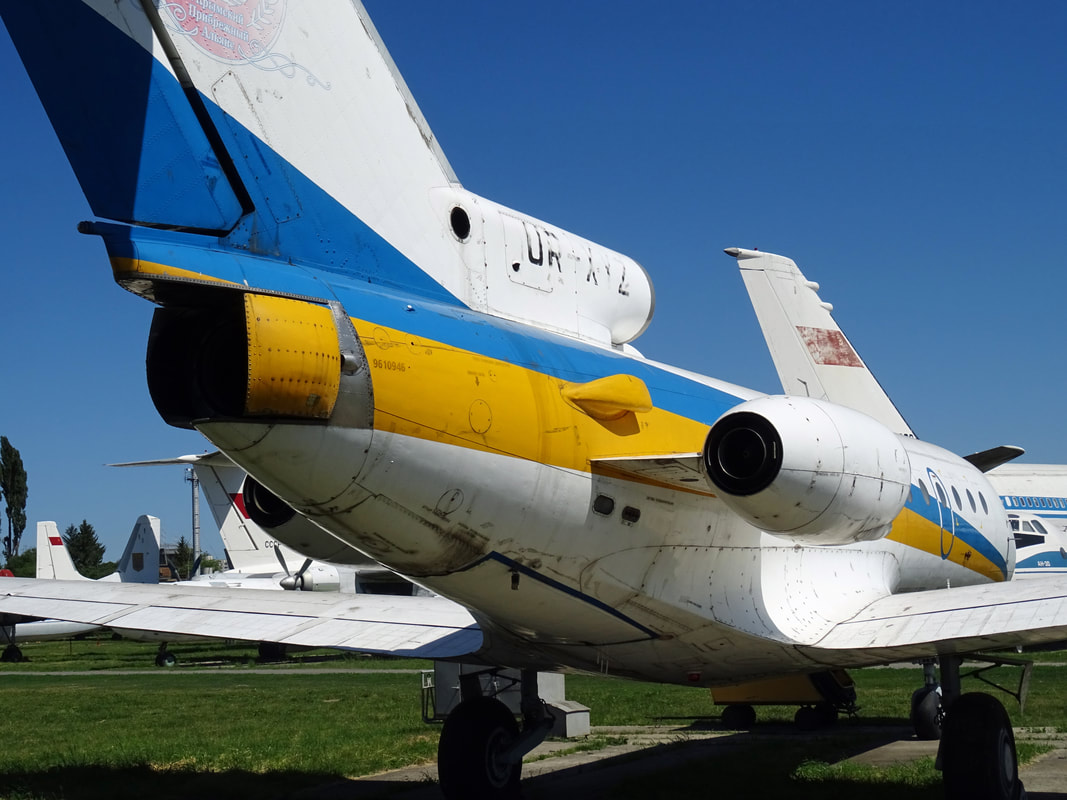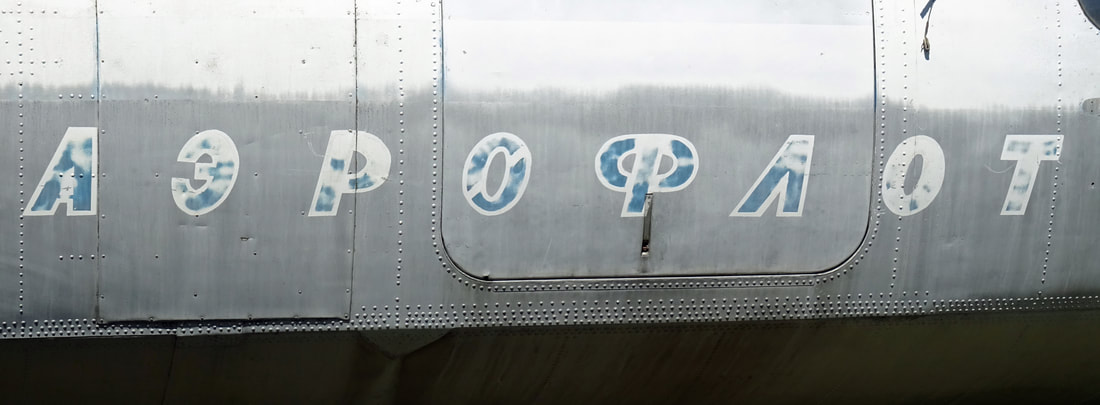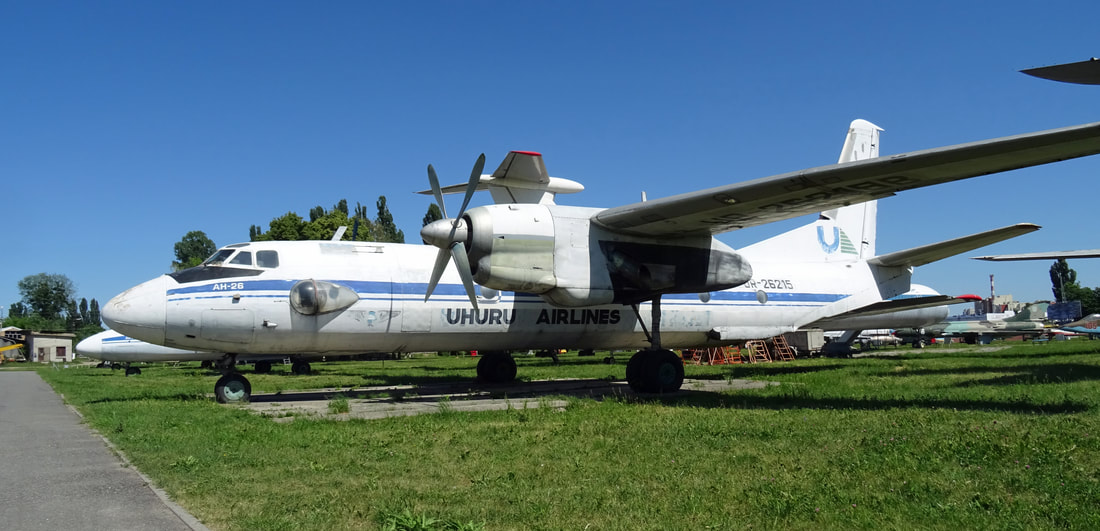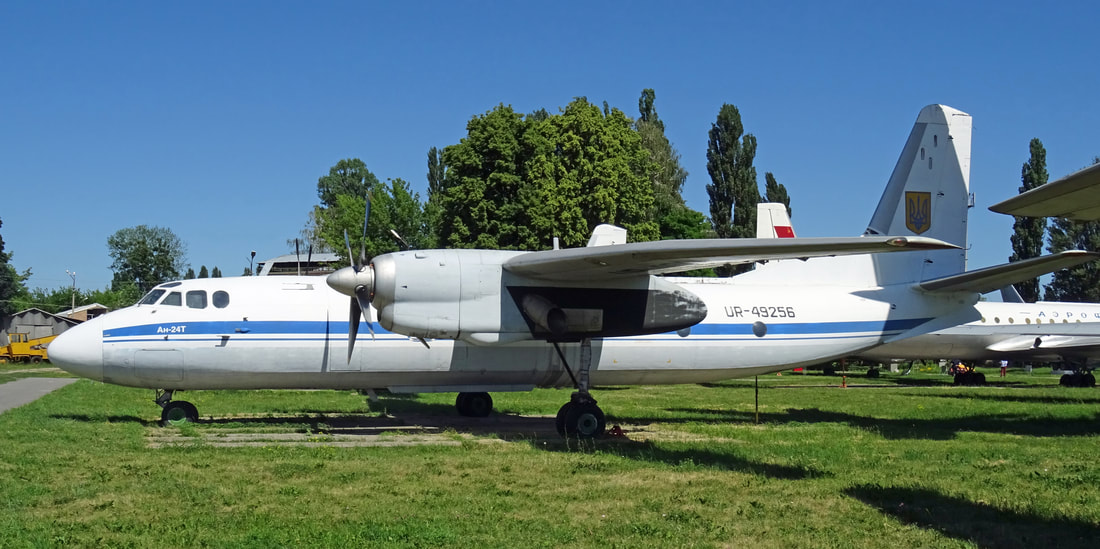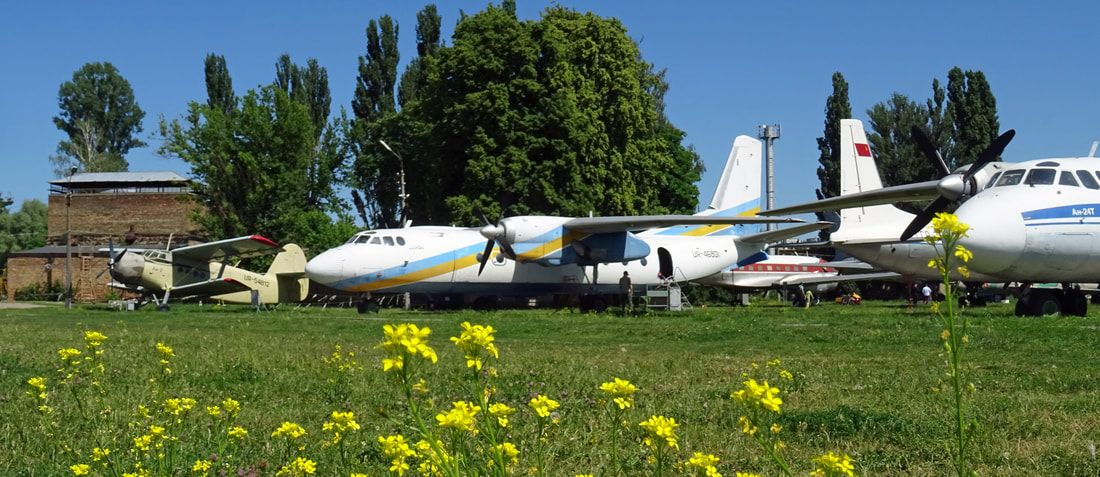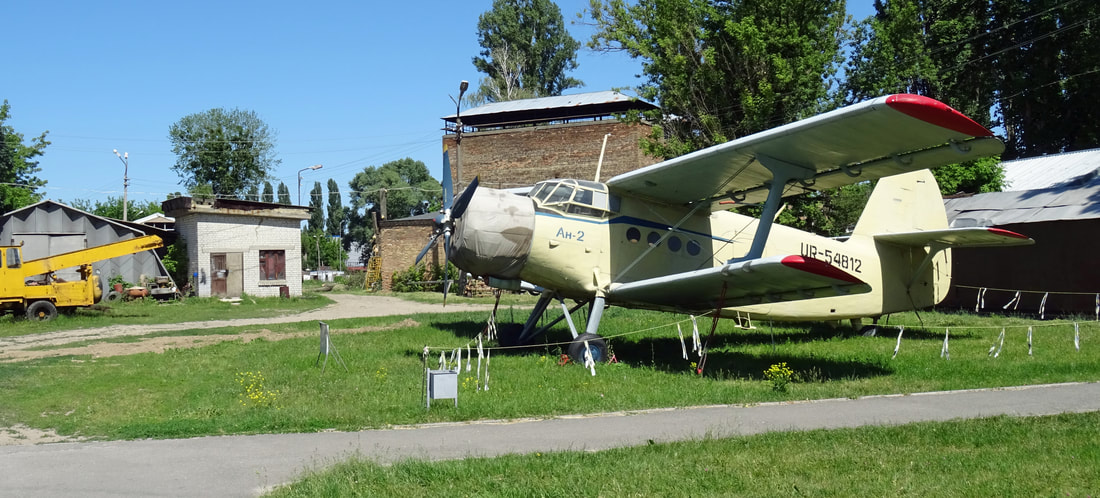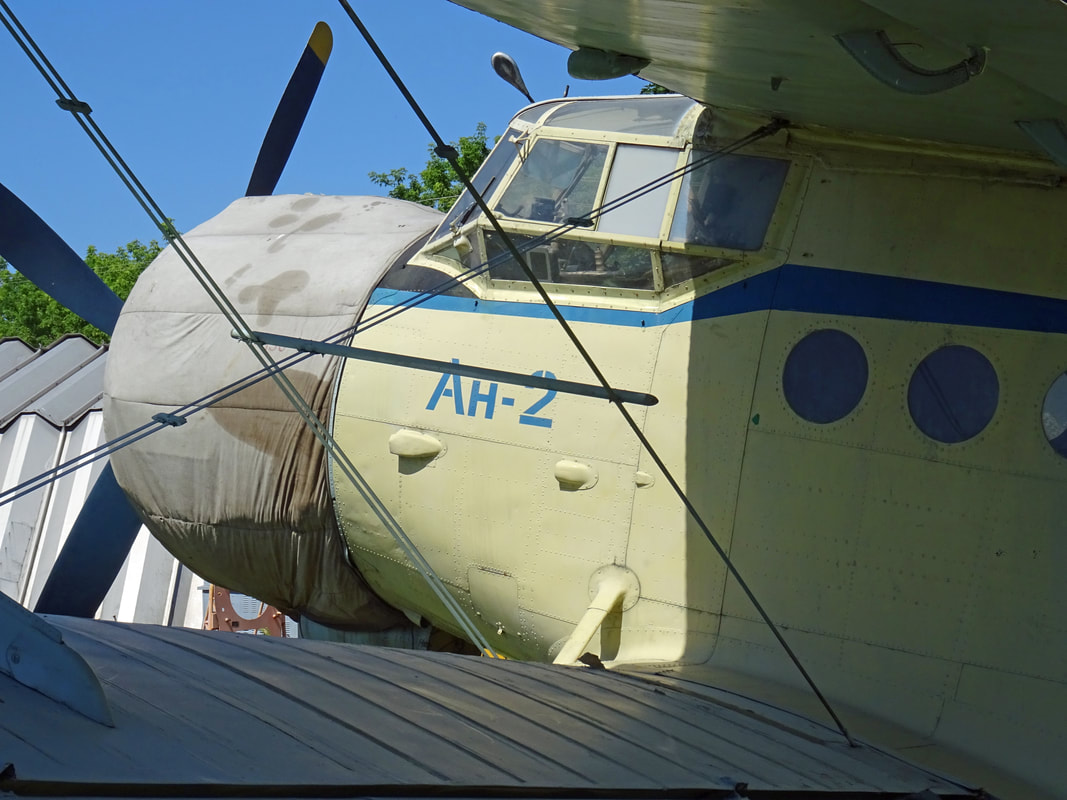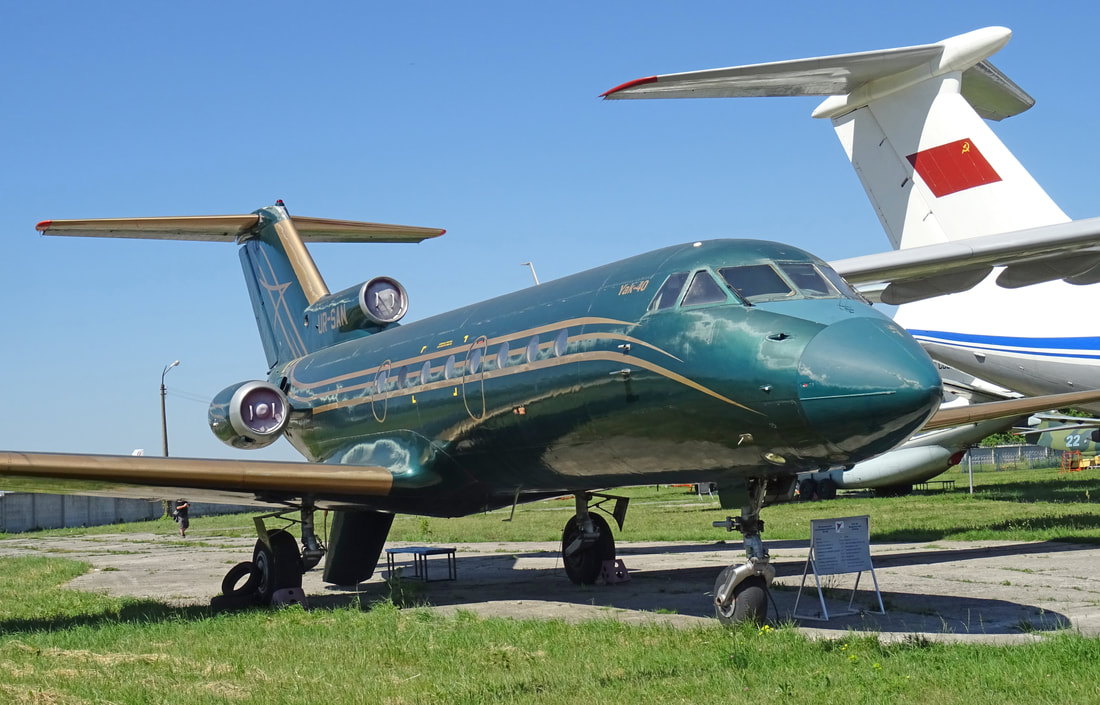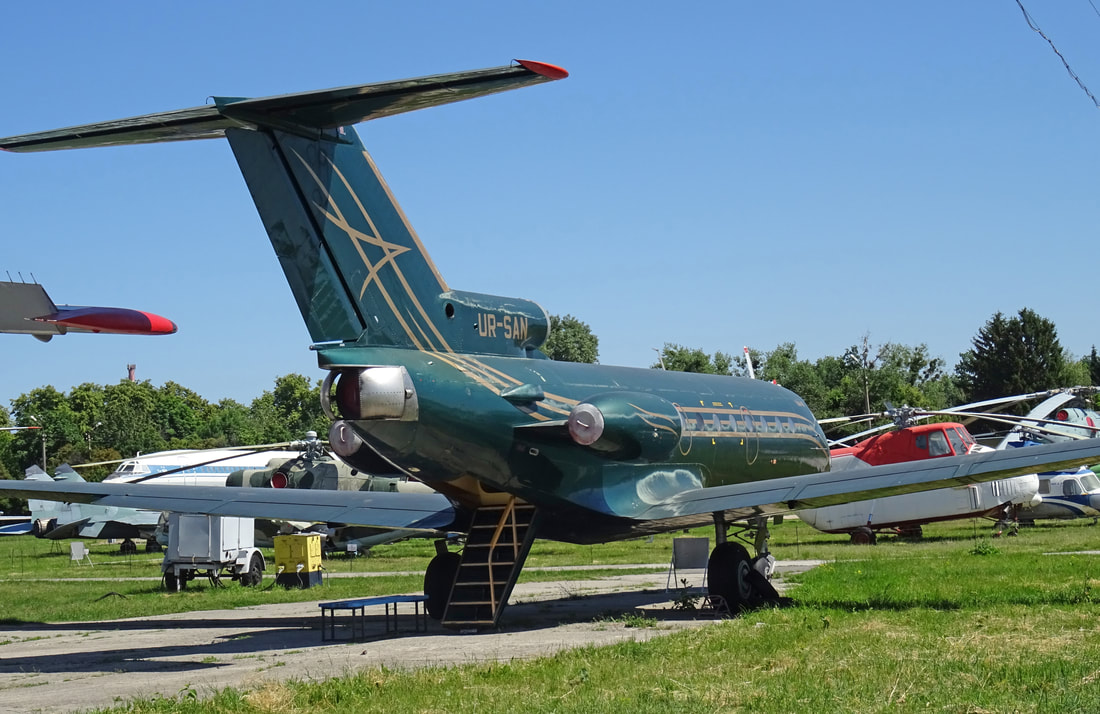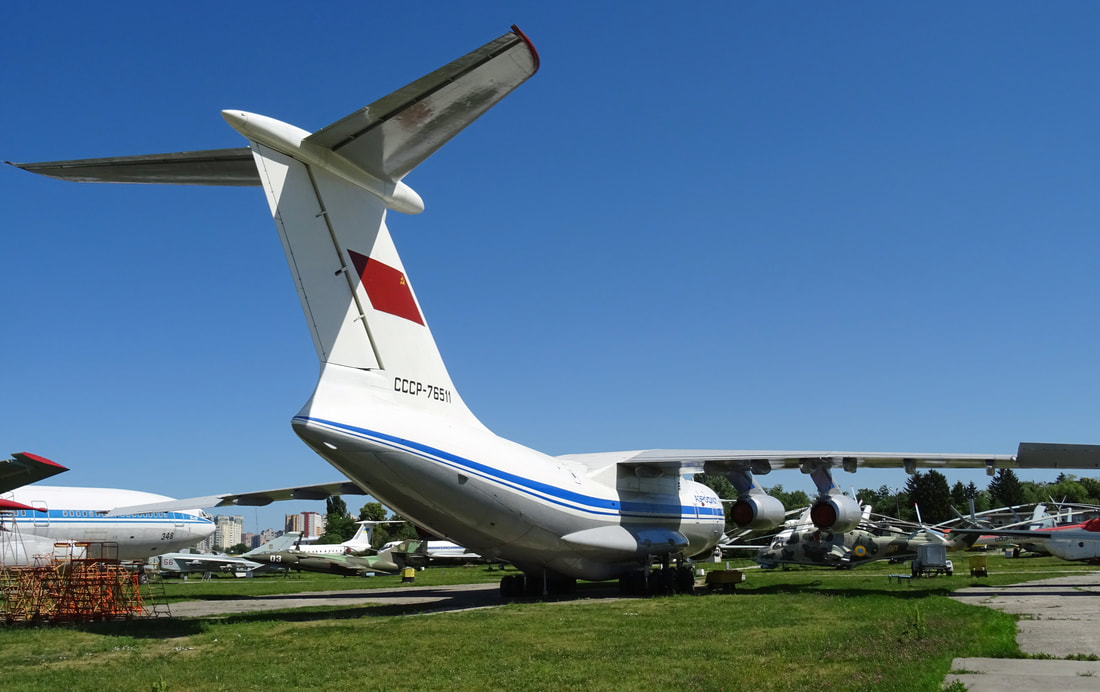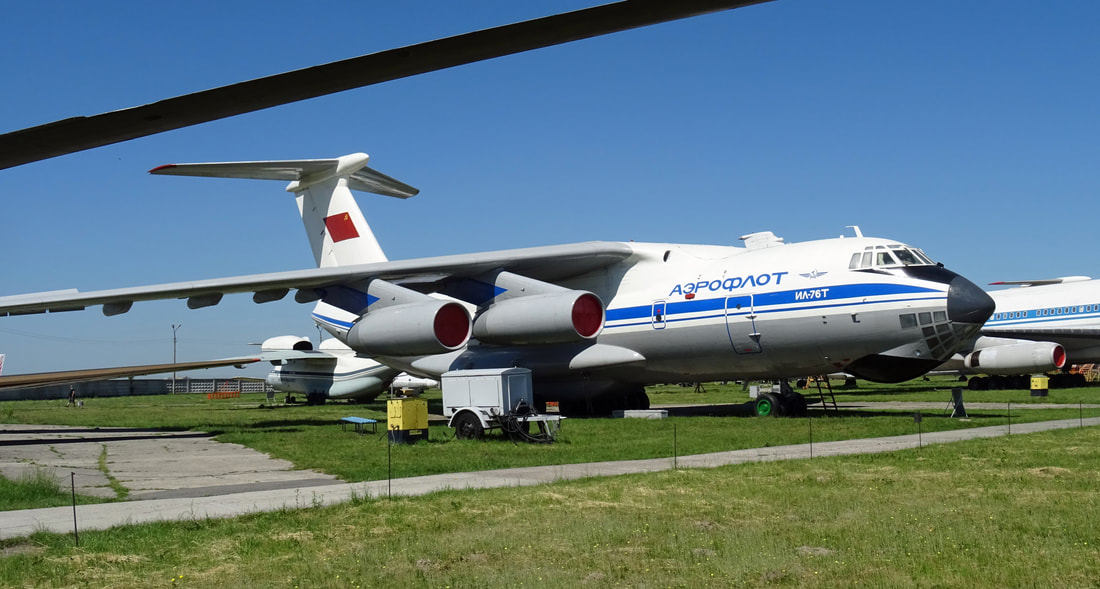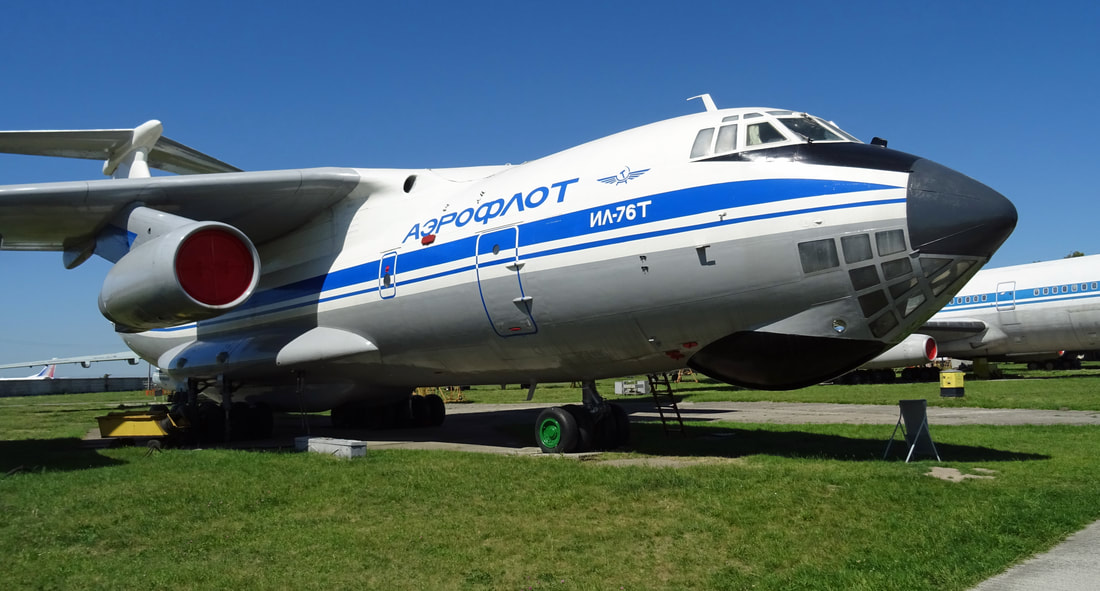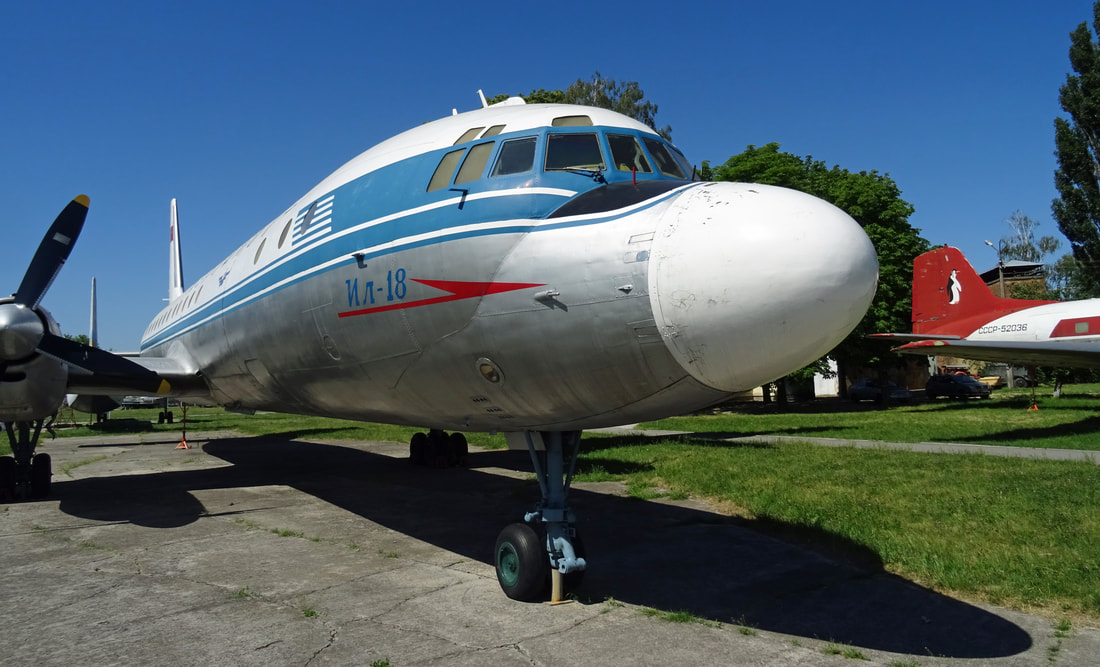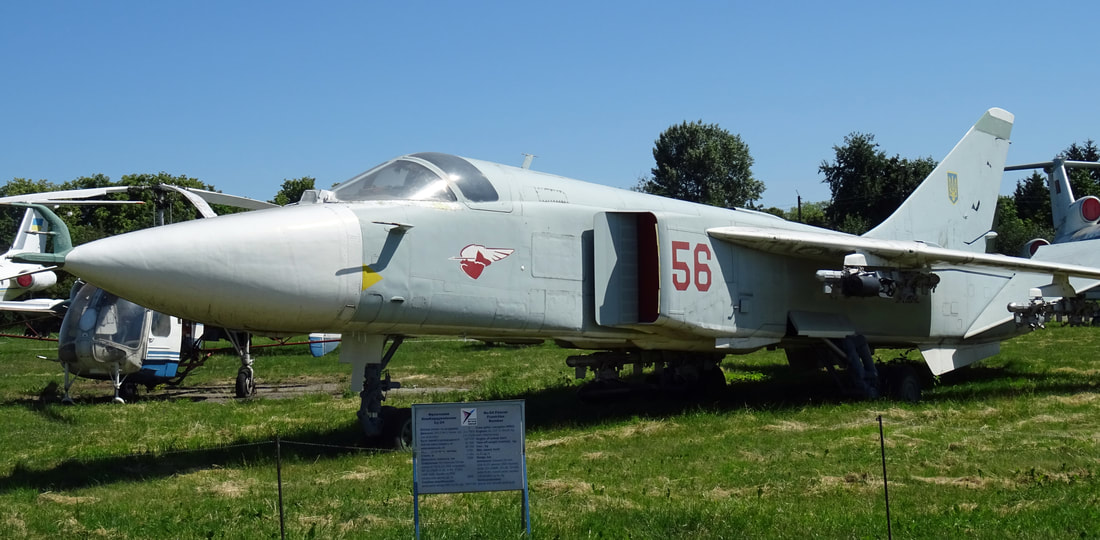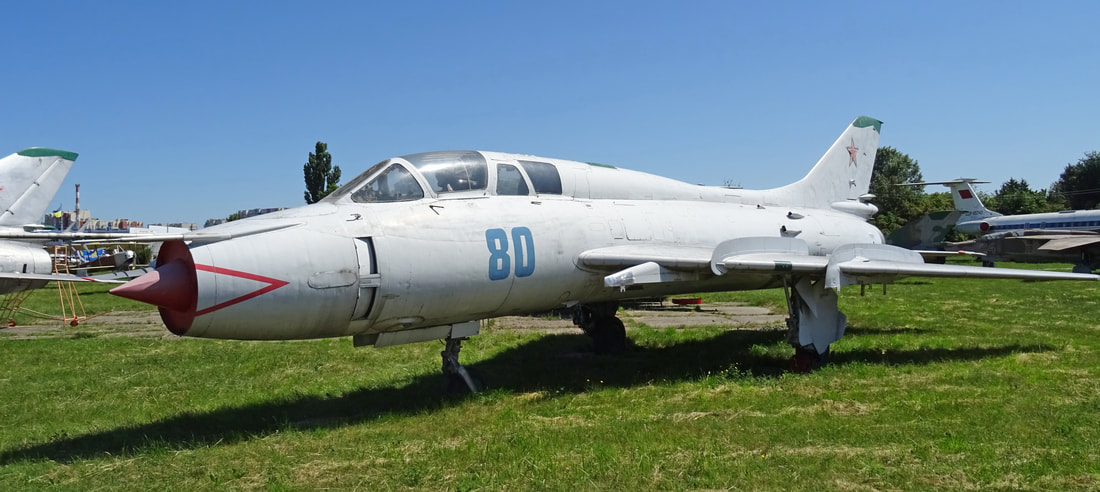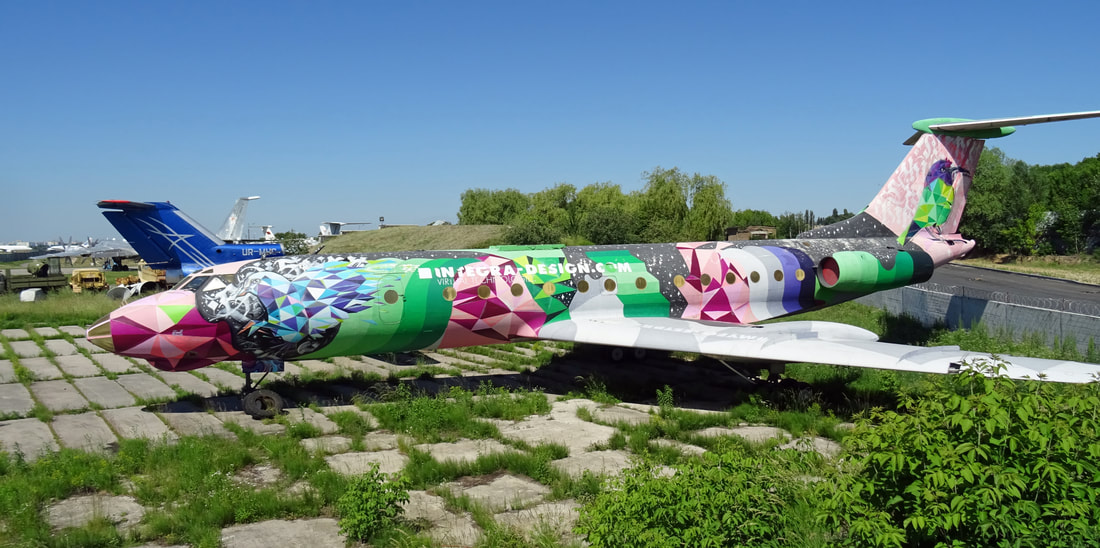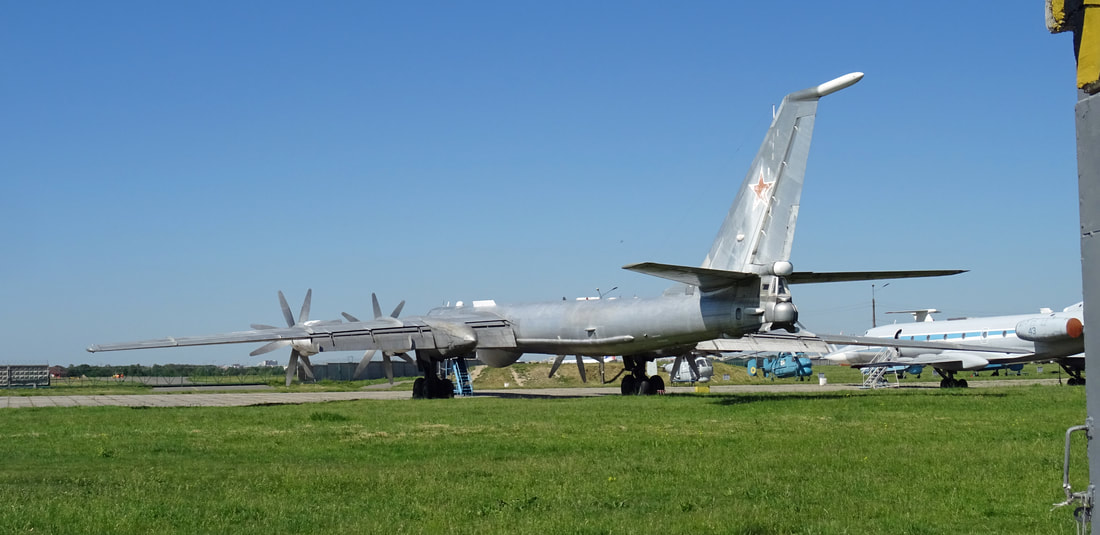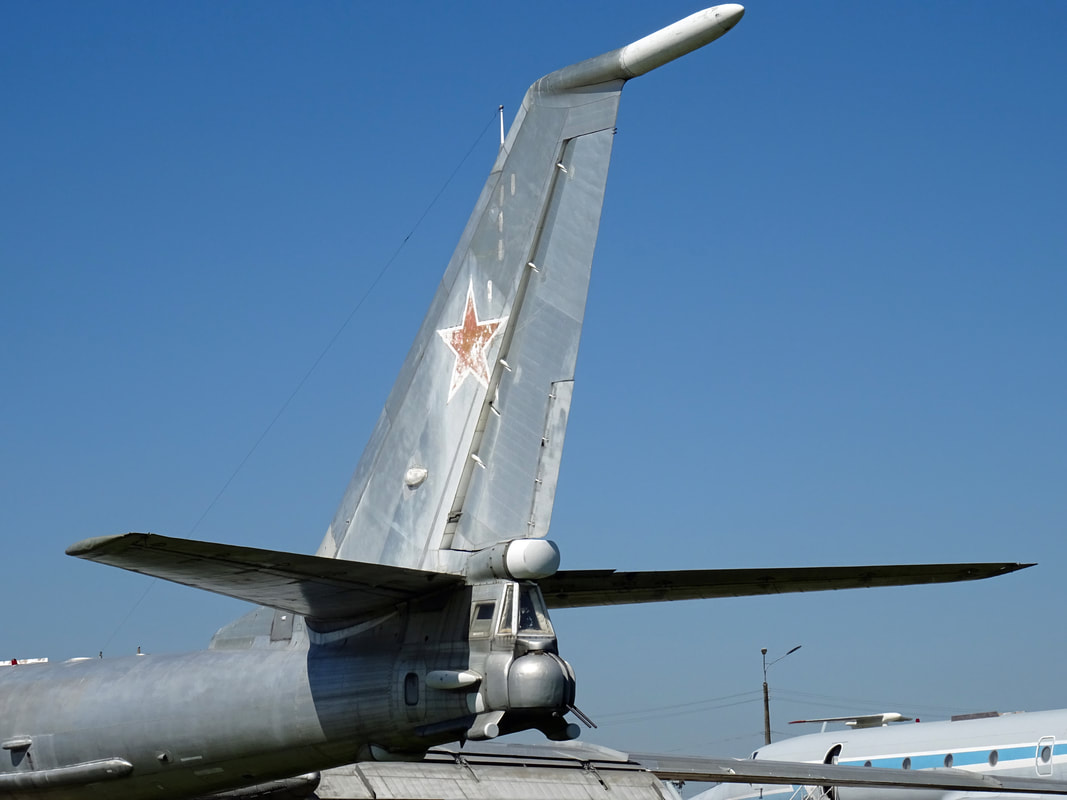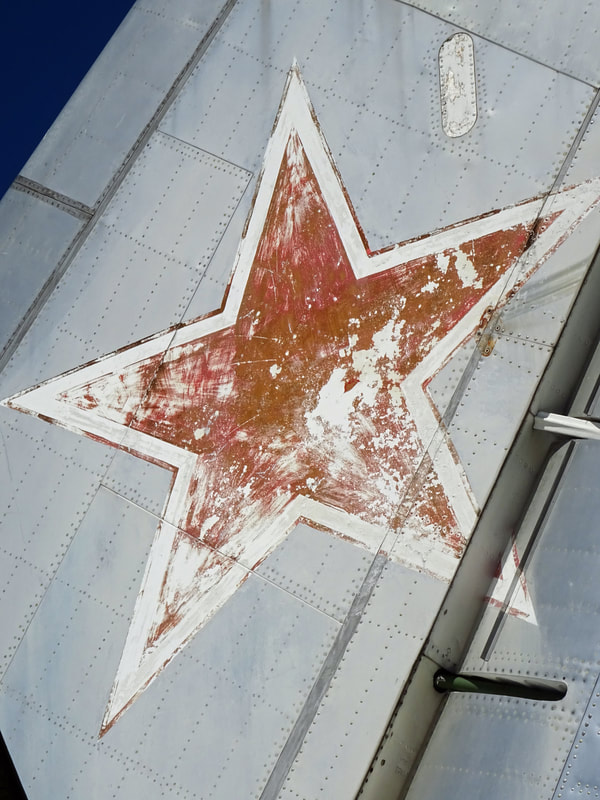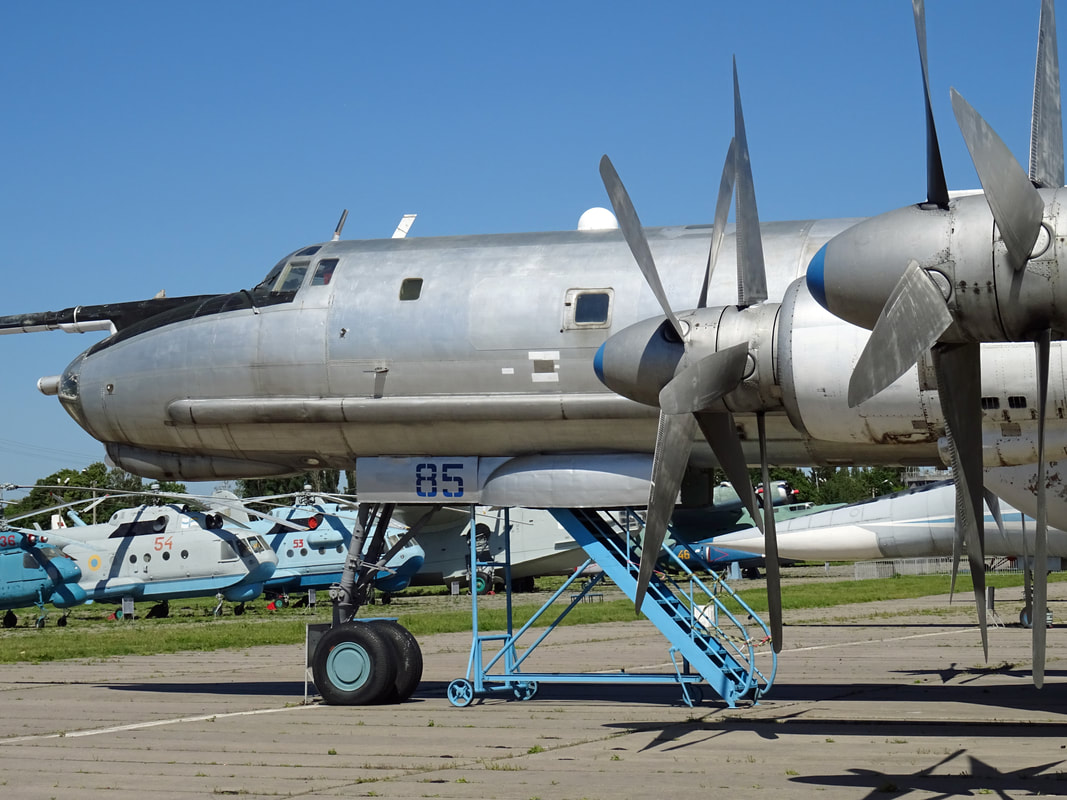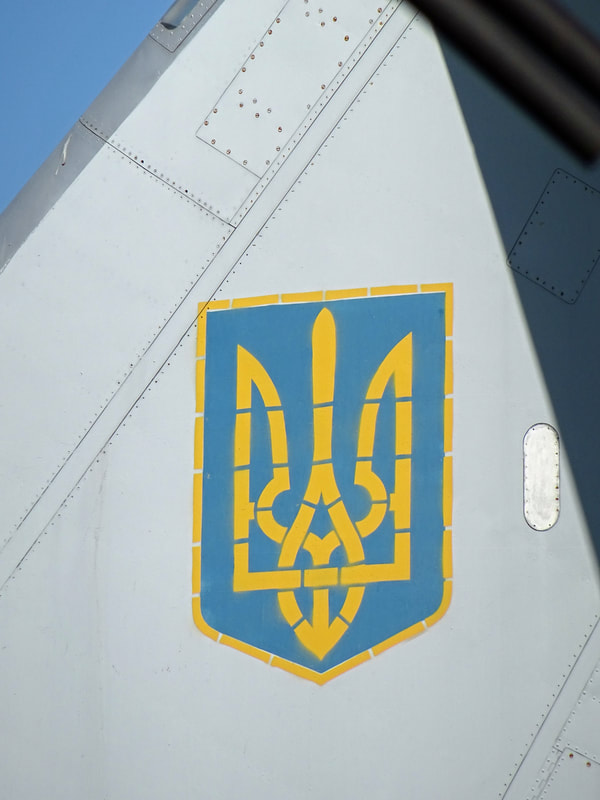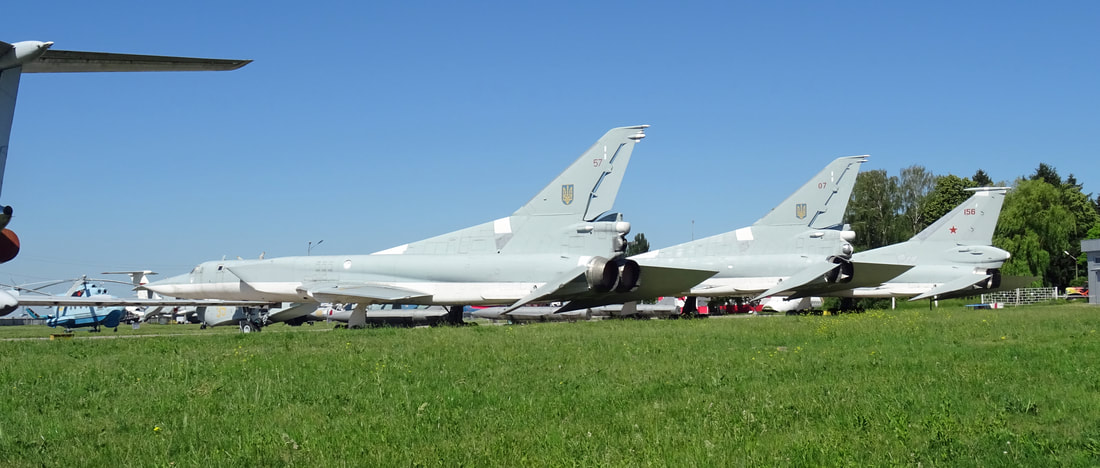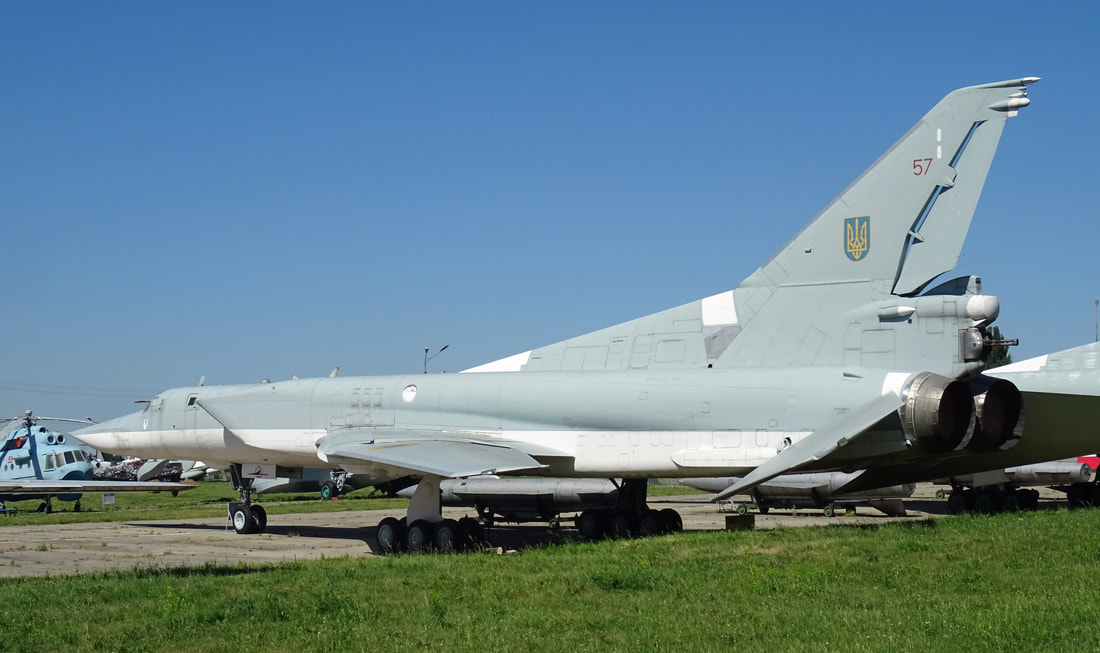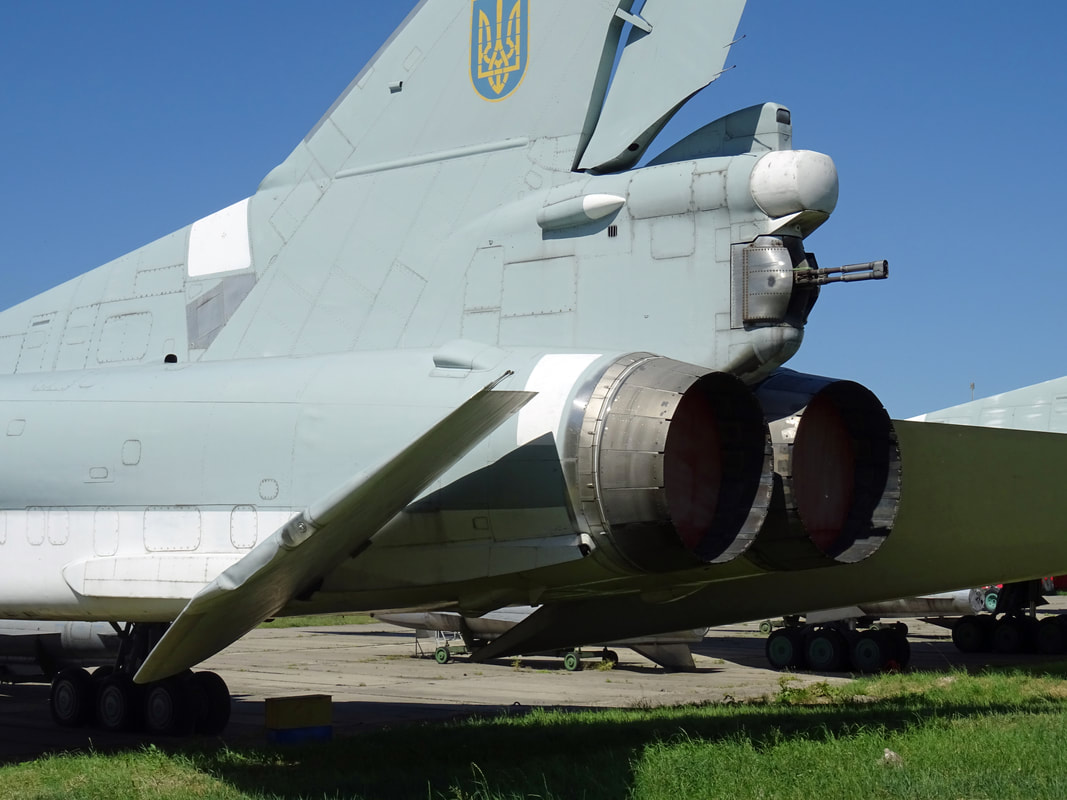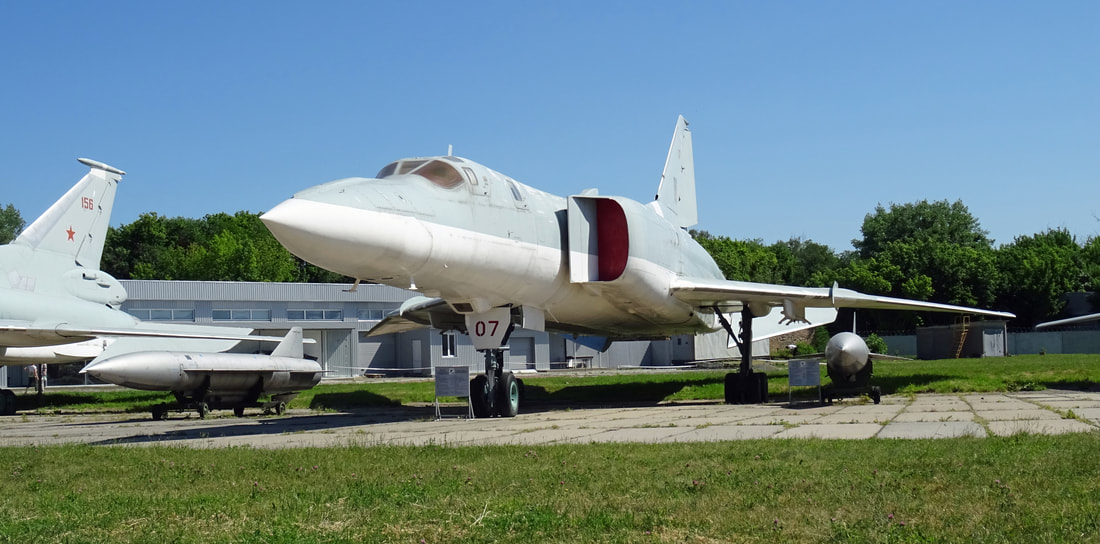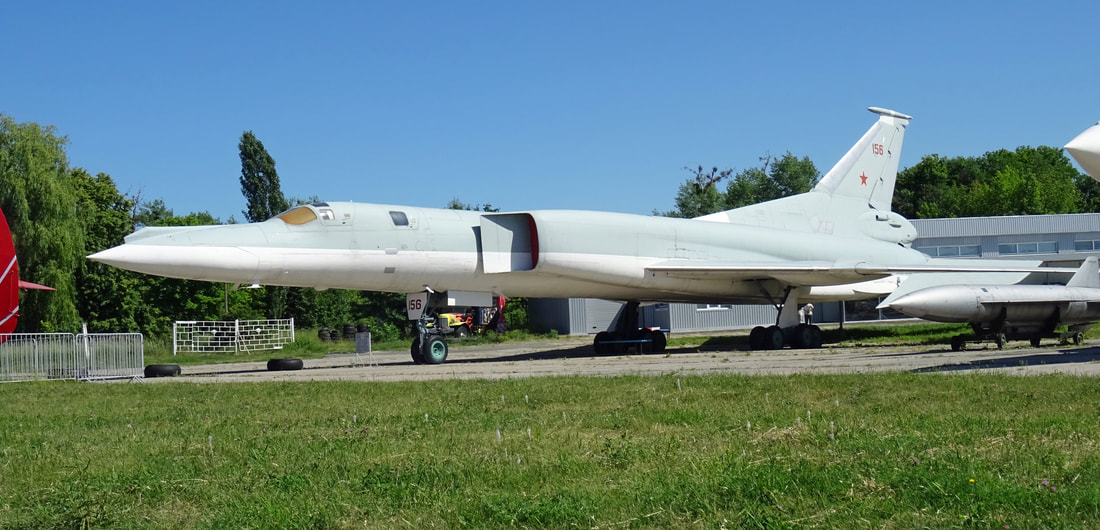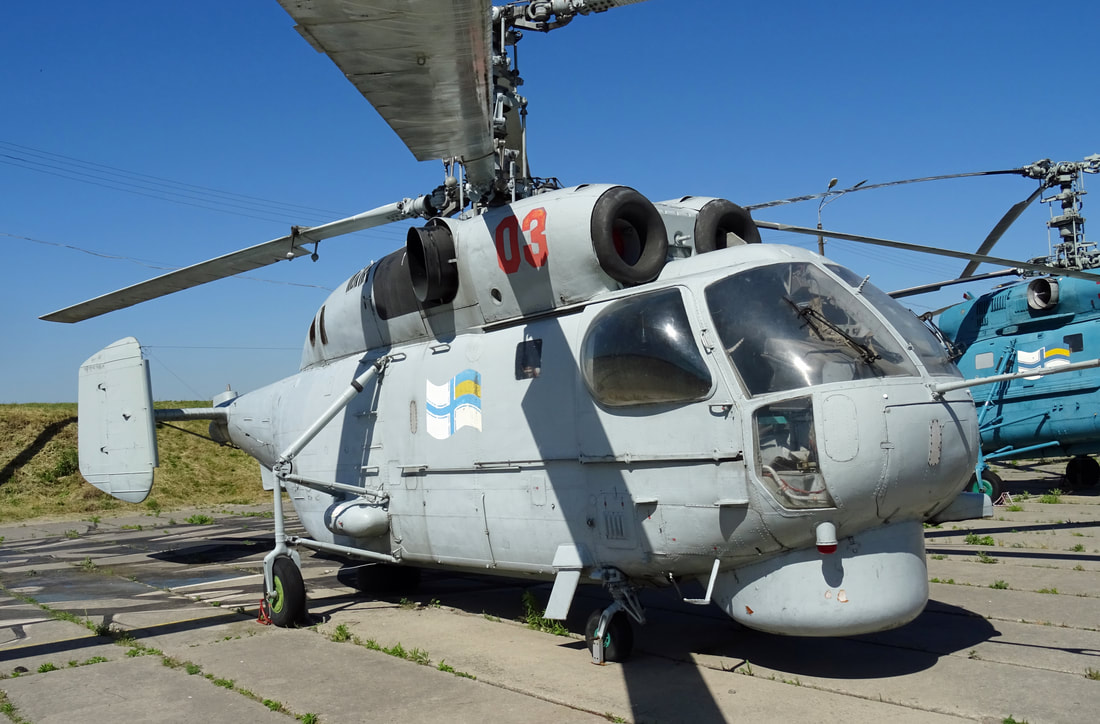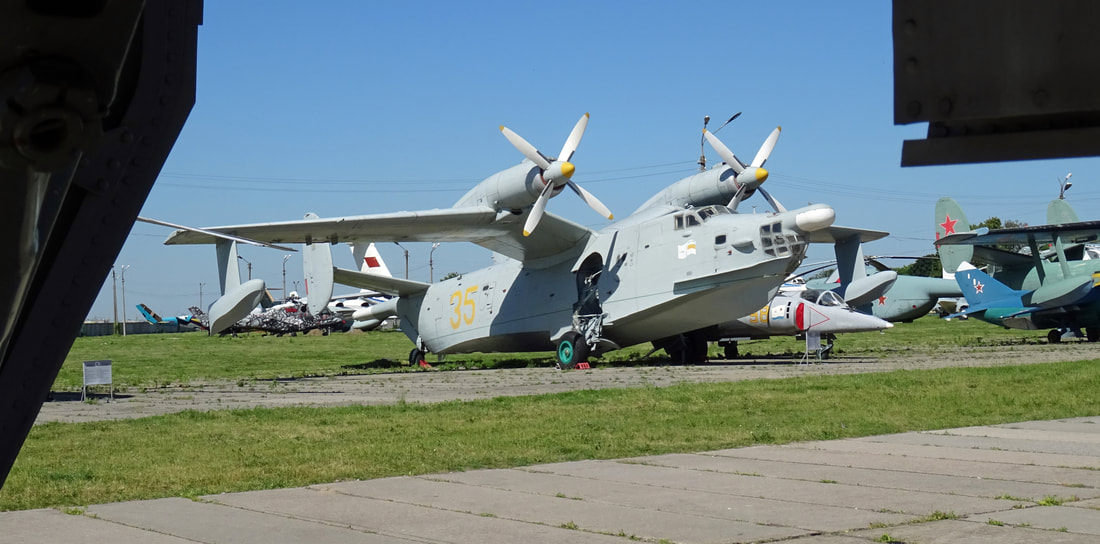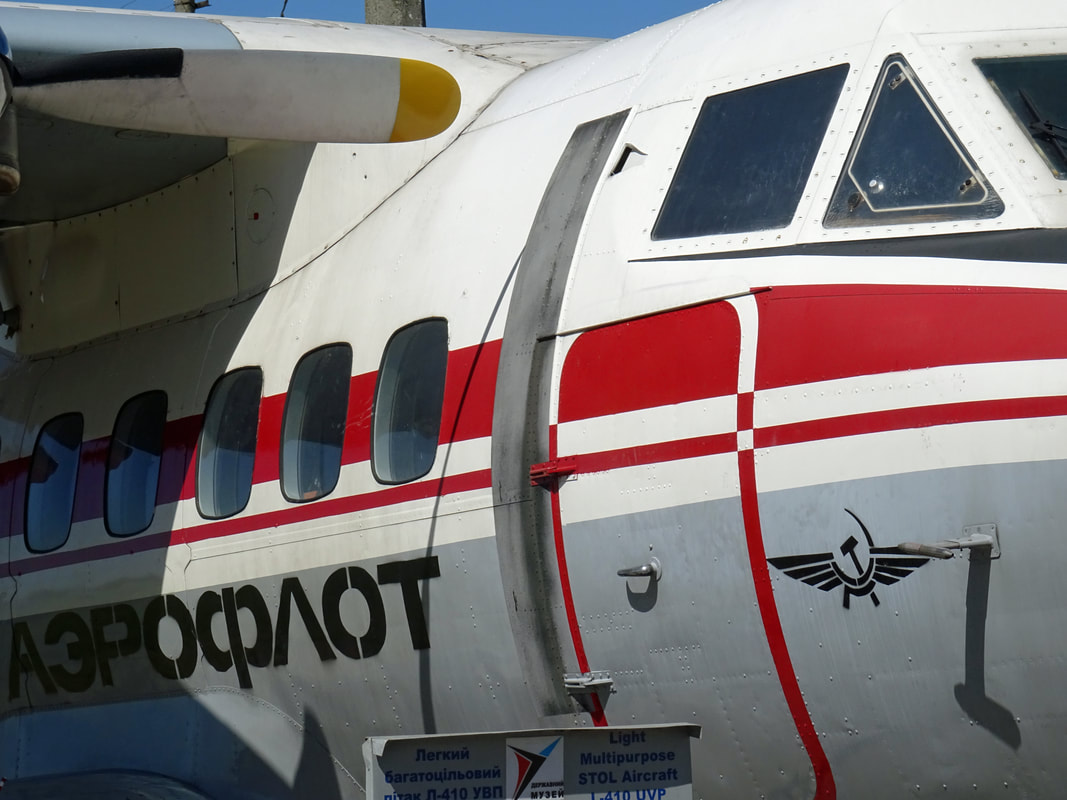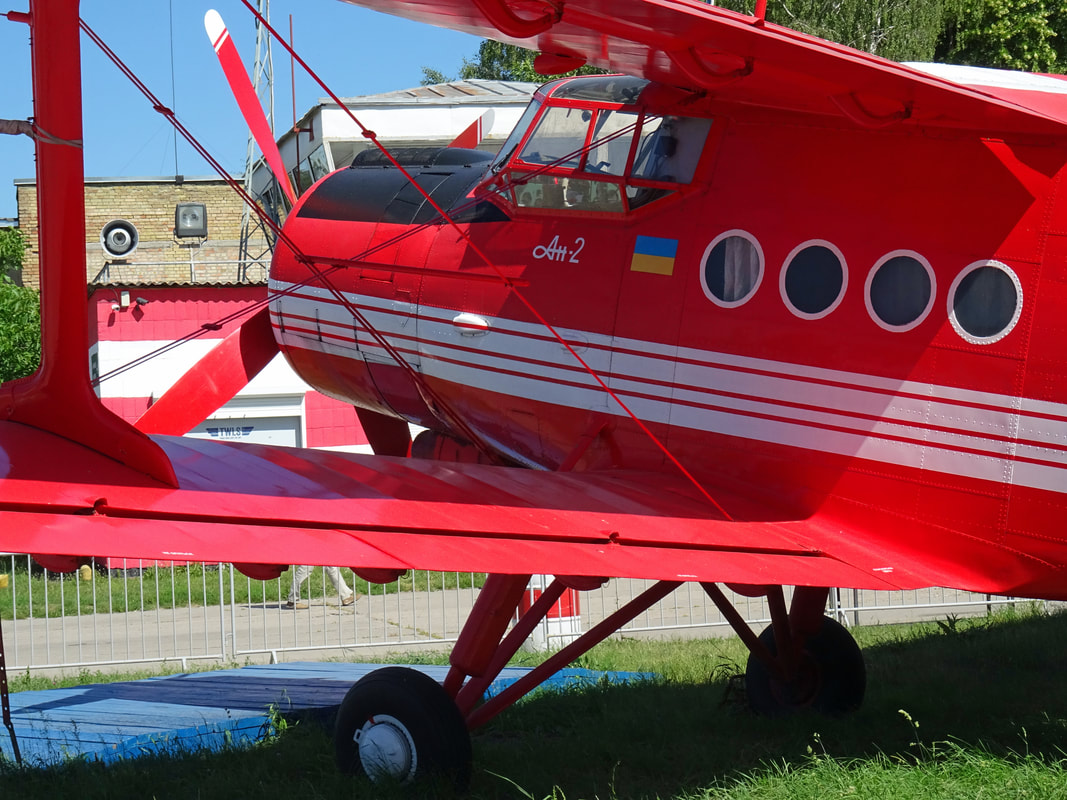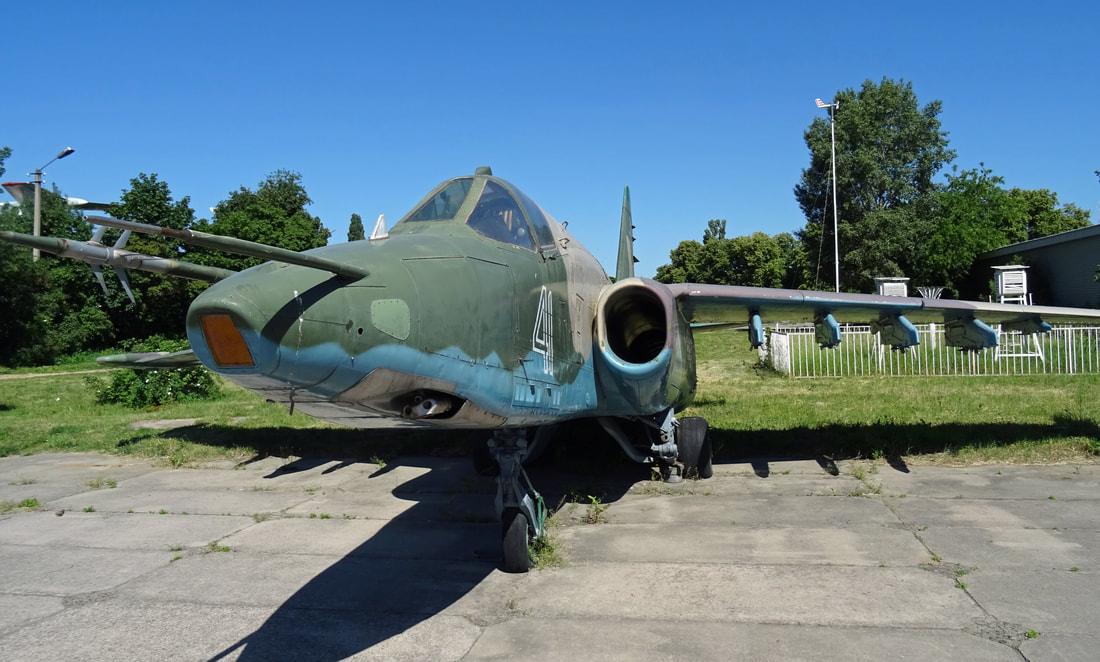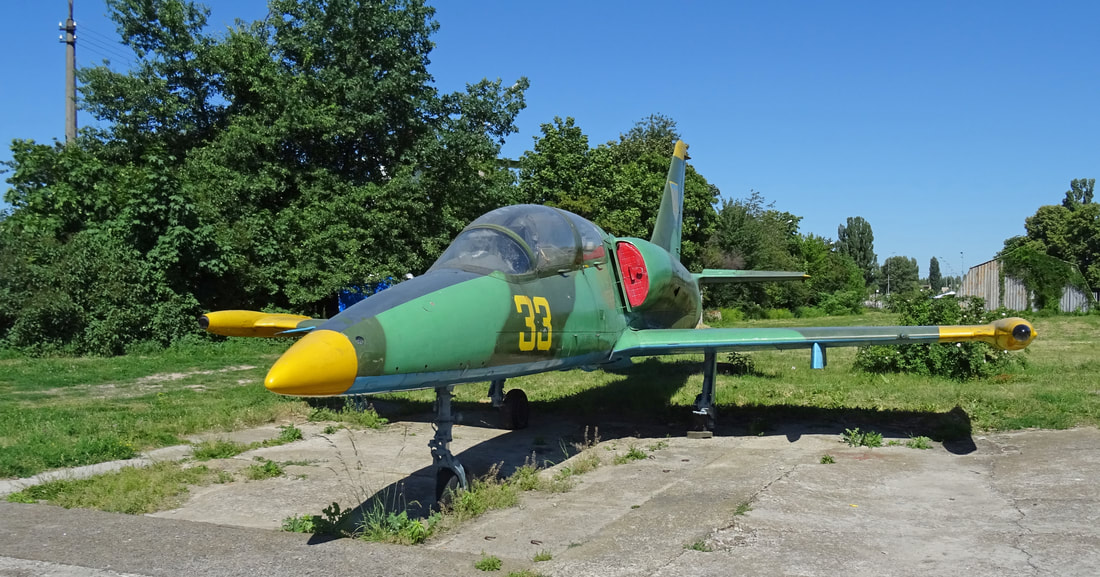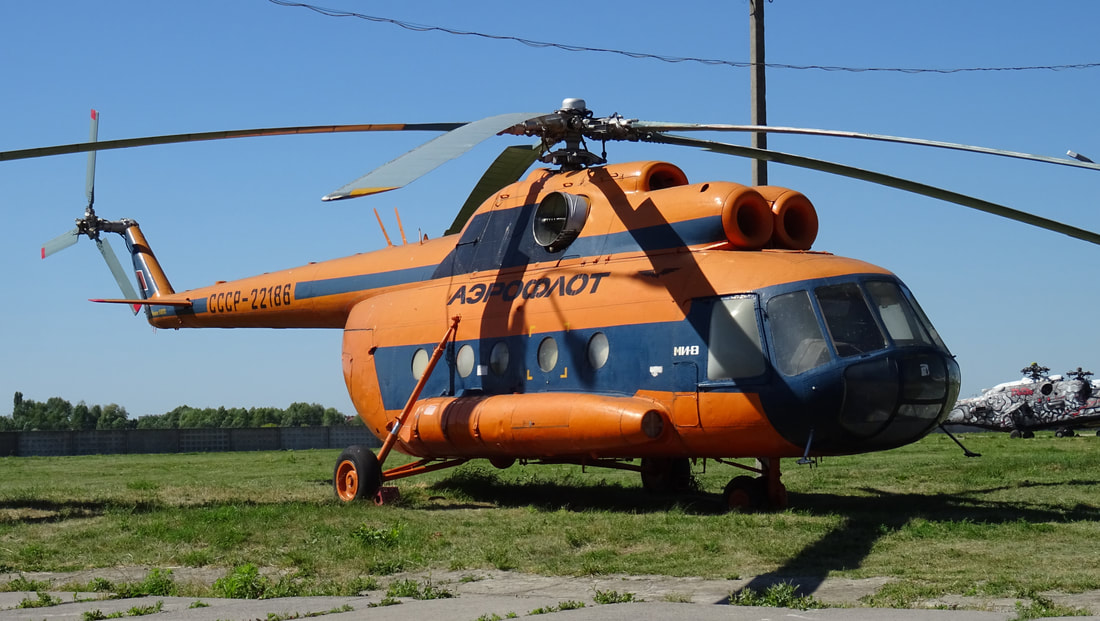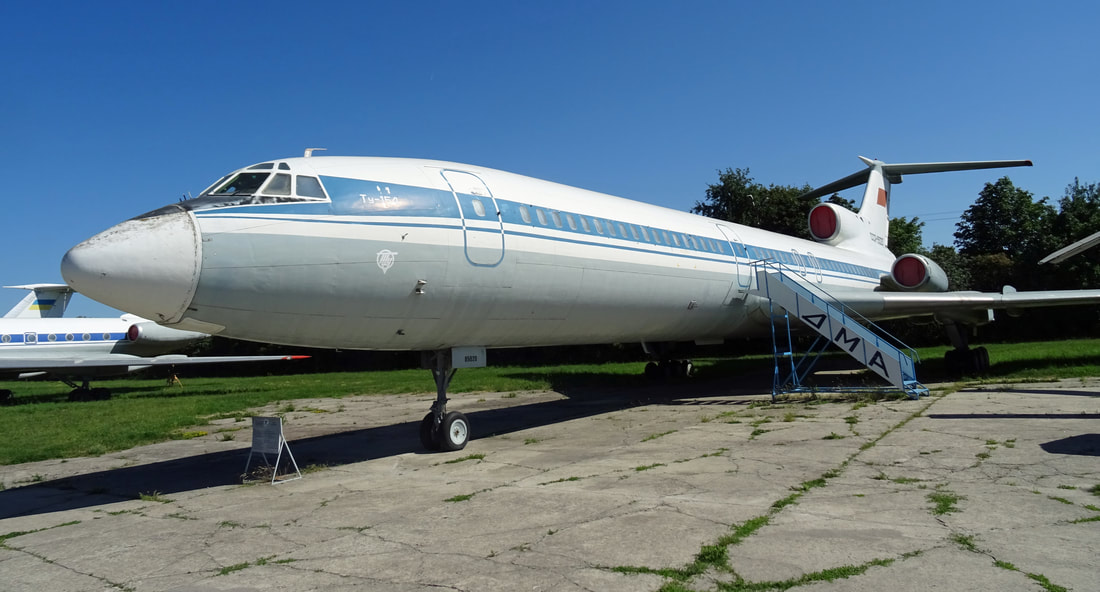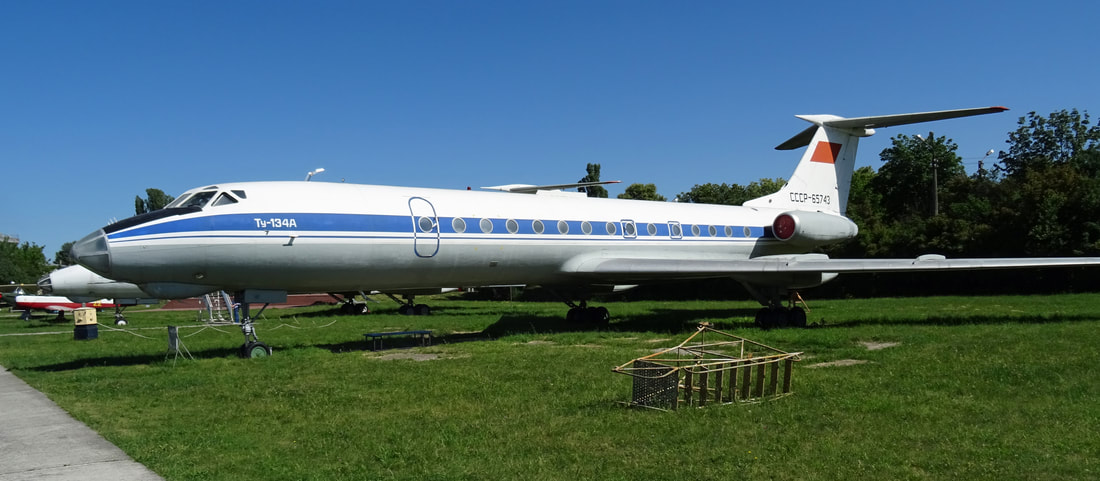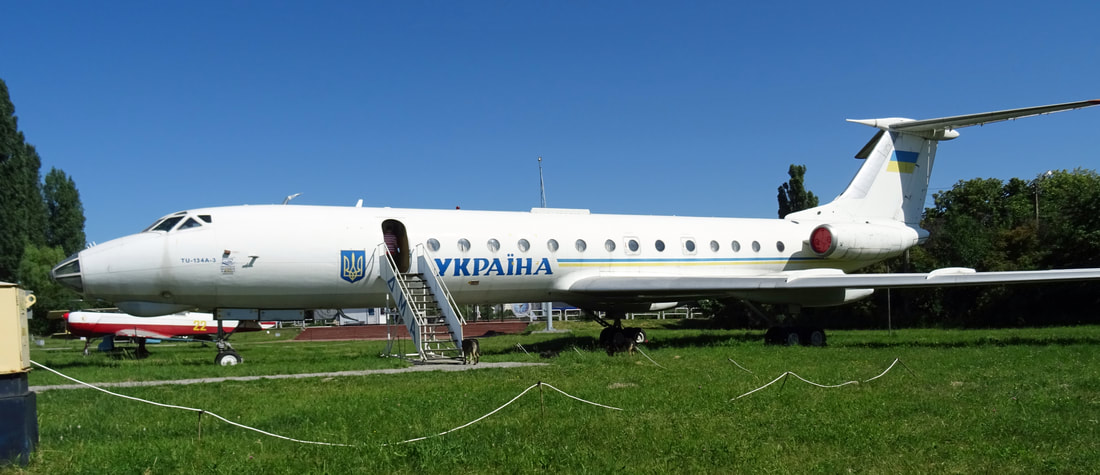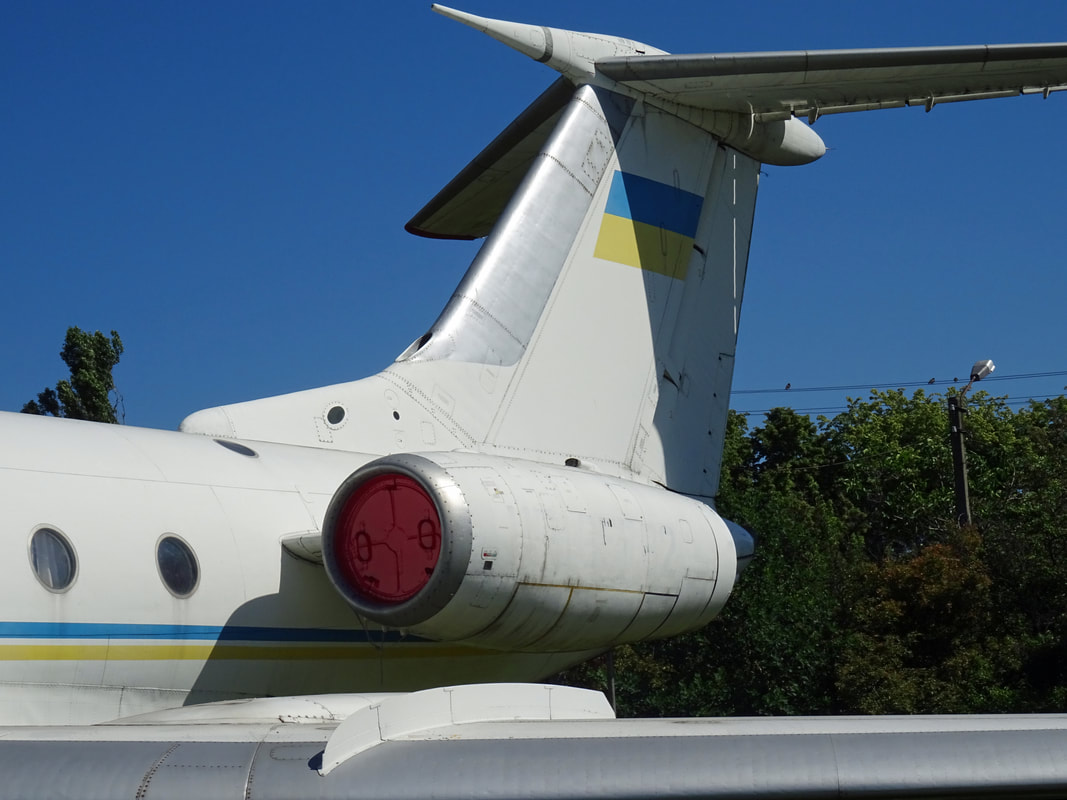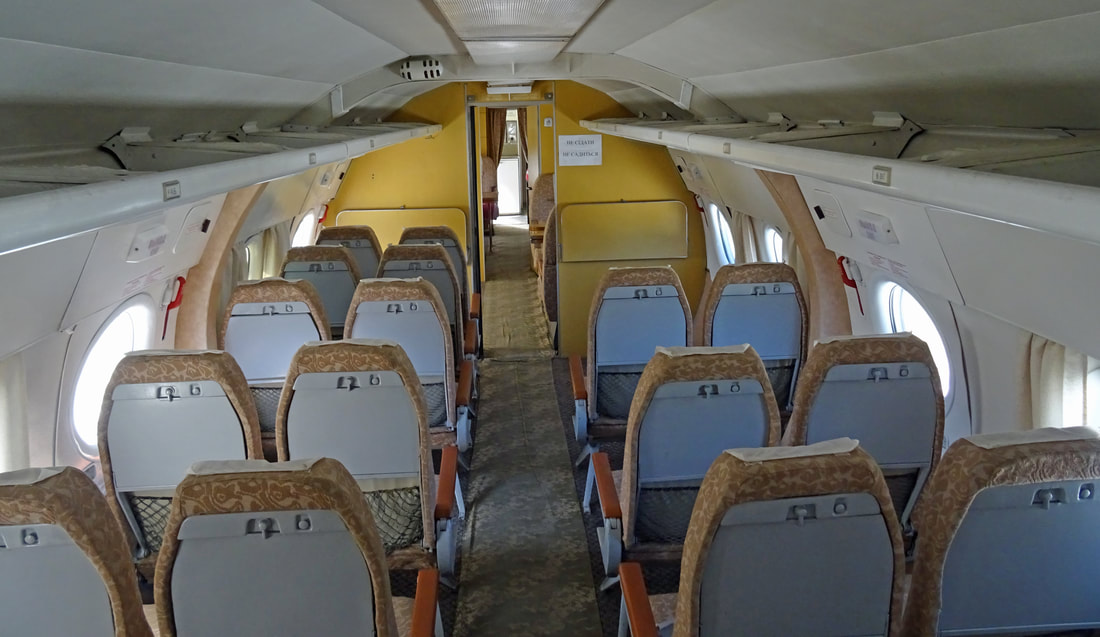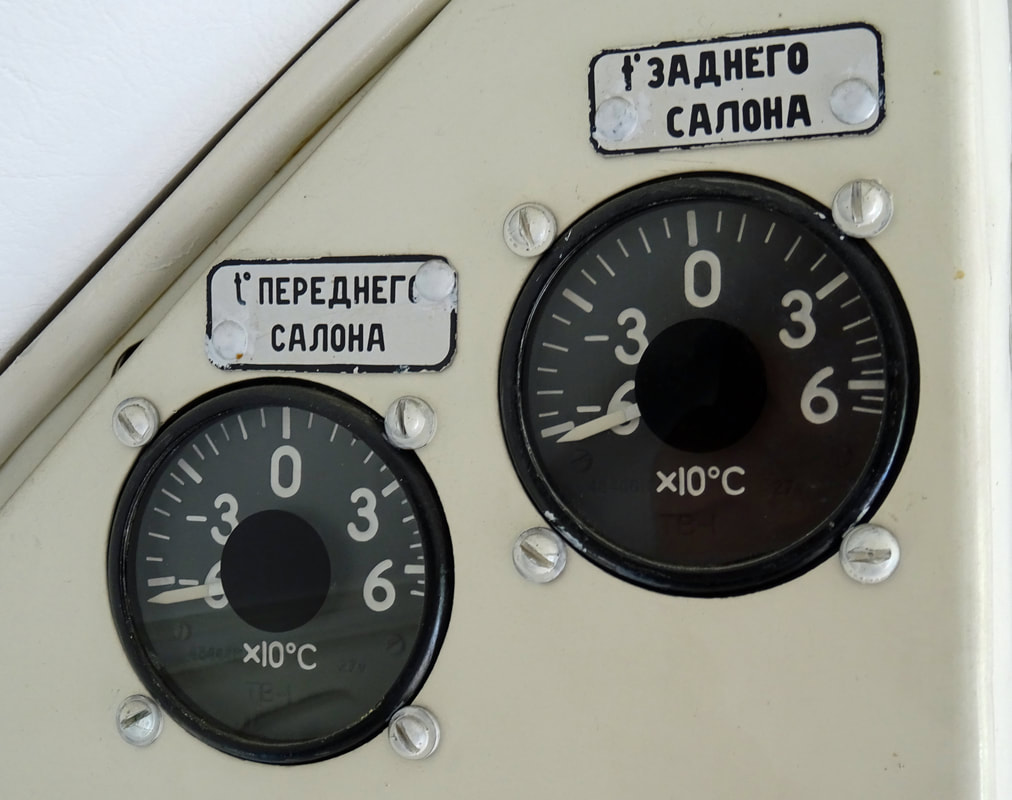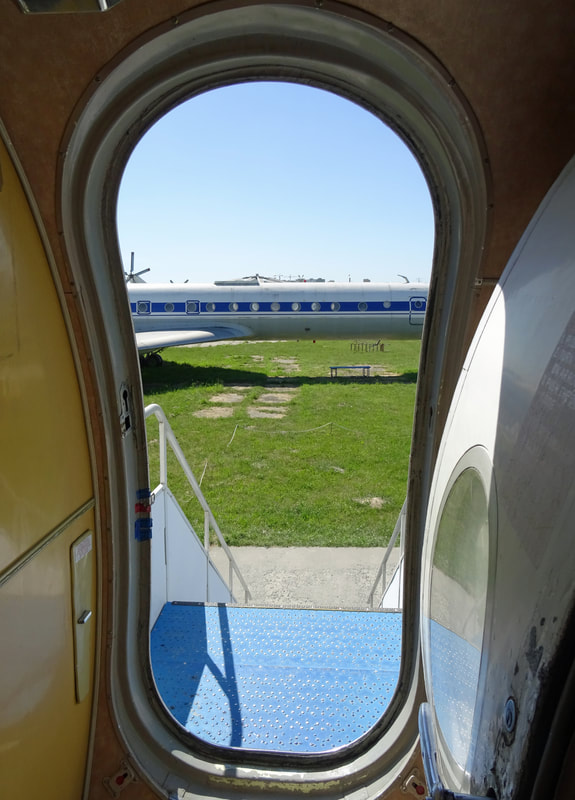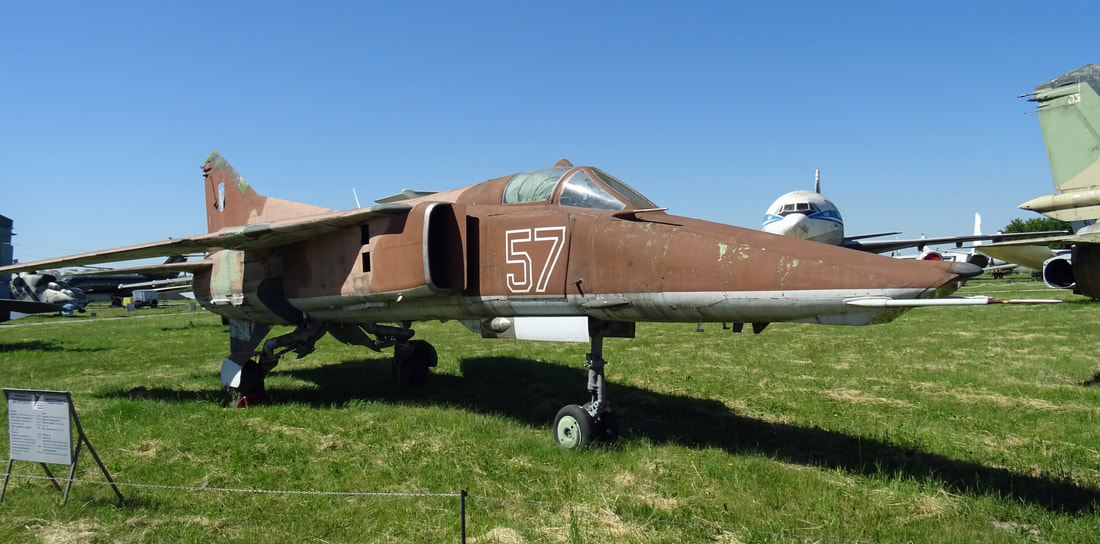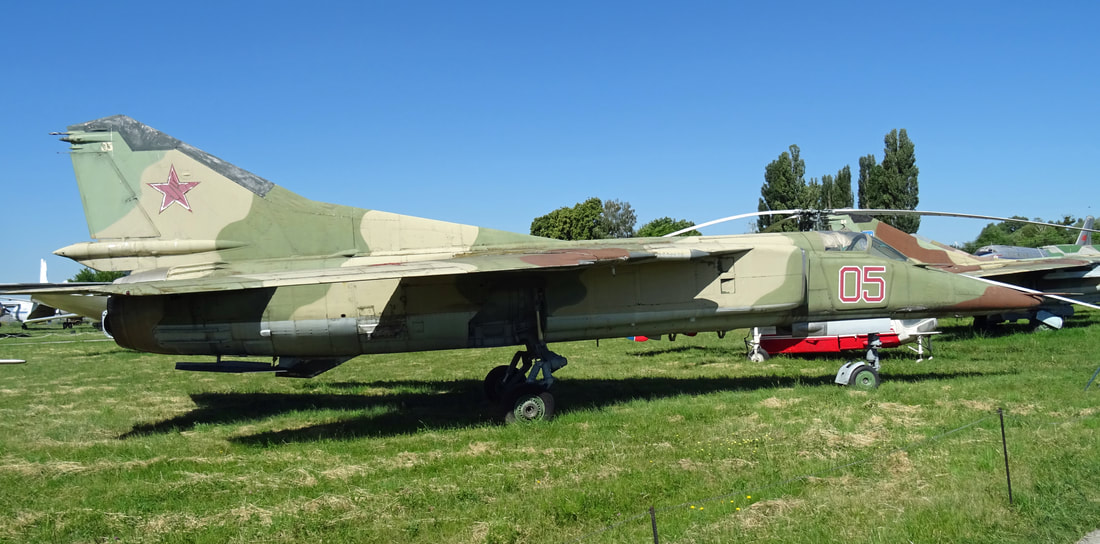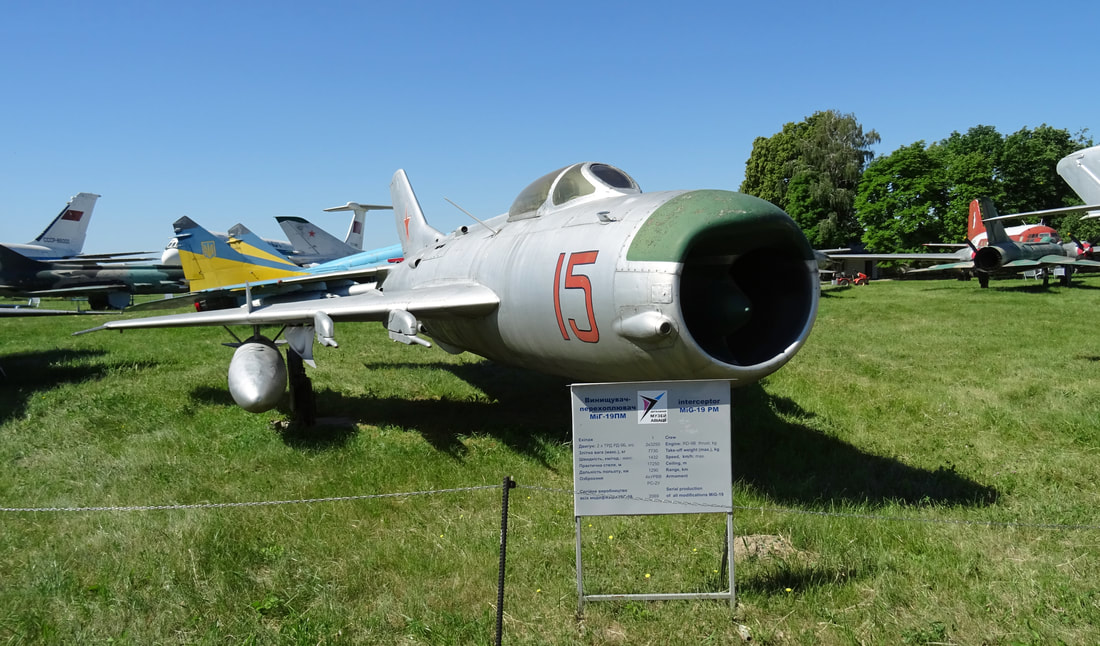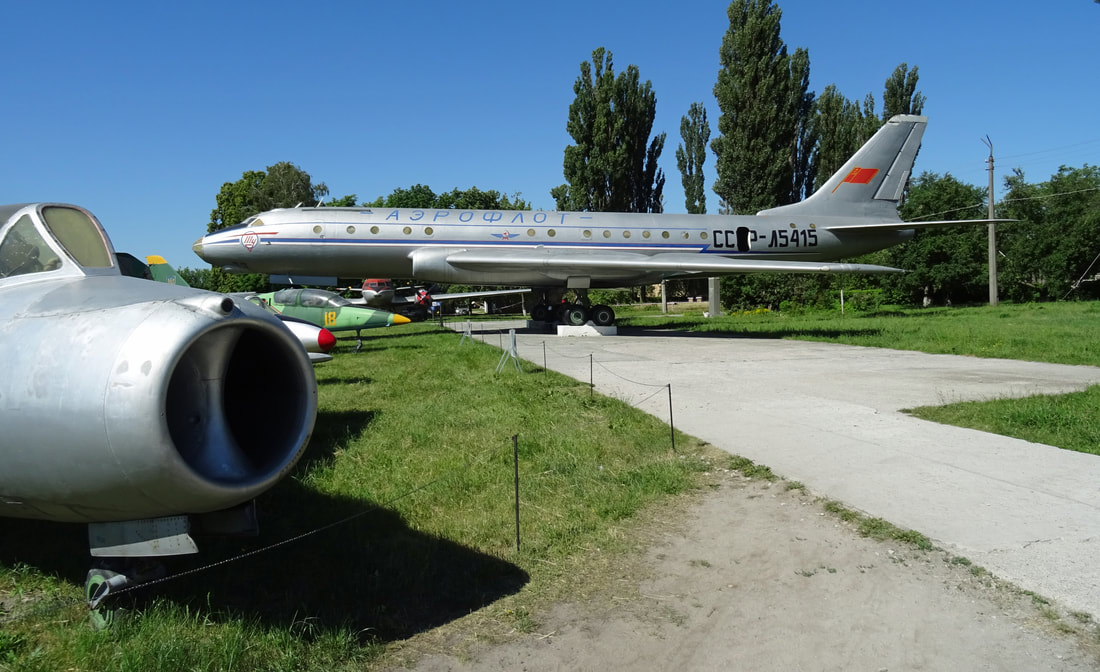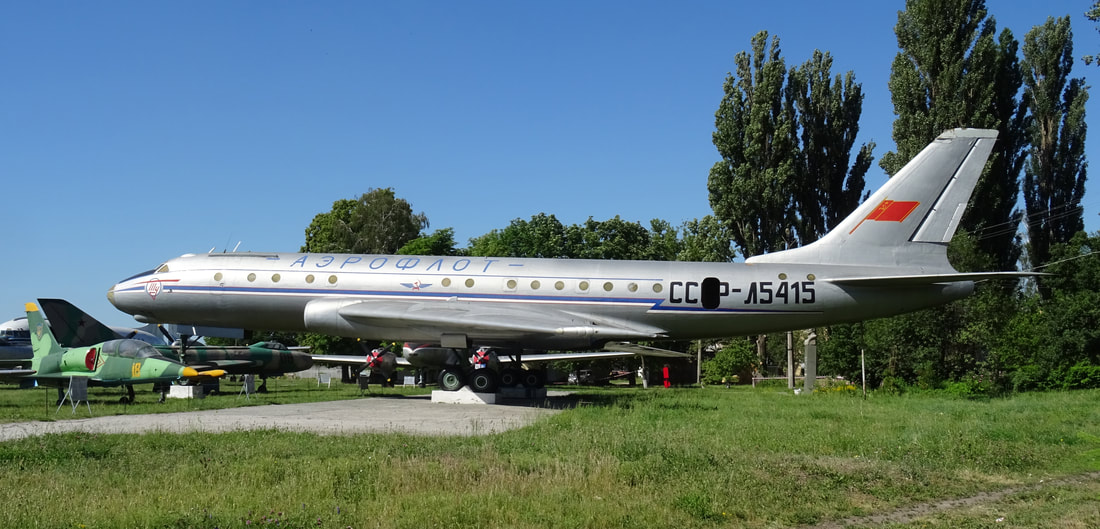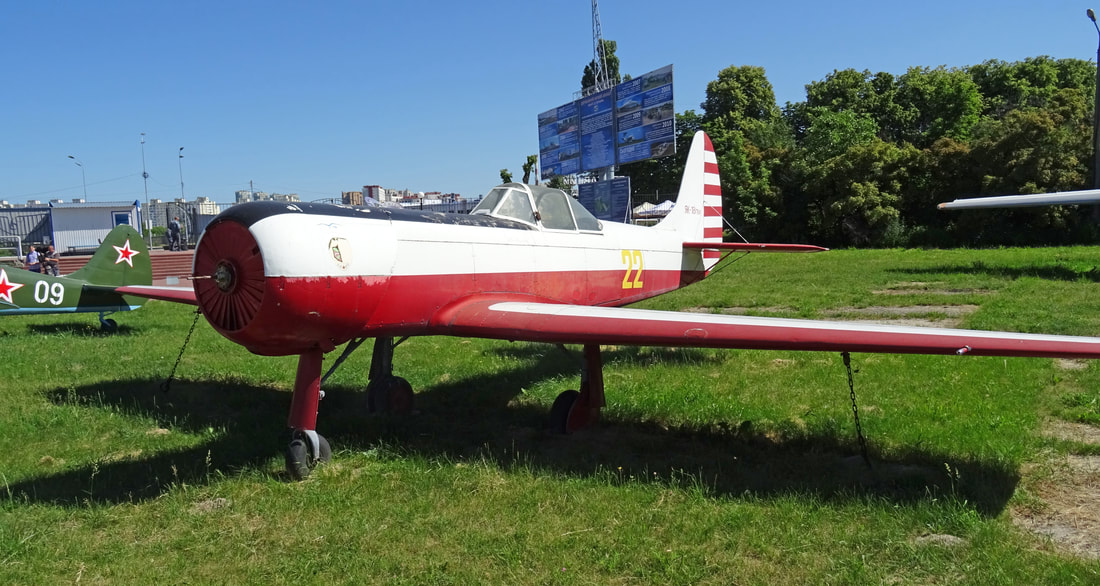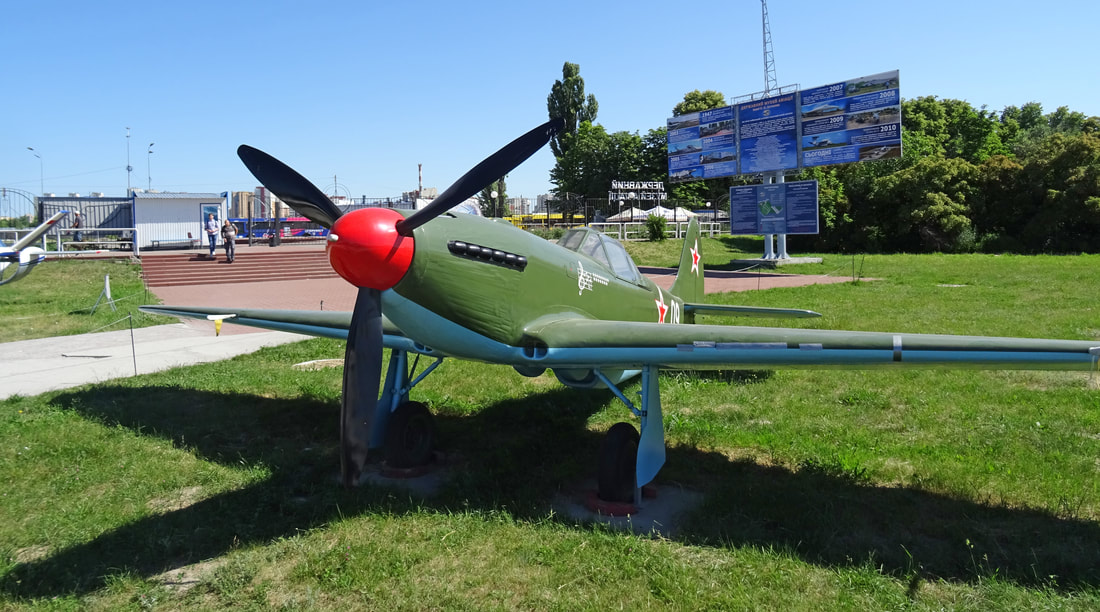State Aviation Museum Zhuliany - Kyiv
by Jan Koppen
In June 2018, I visited, with several aviation friends, the Ukraine. Next to a a very interesting visit to Chernobyl, the Aviation Technical School in Kyiv and a Motor Sich An-24 flight to Odesa, we re-visited the State Aviation Museum at Zhuliany Airport.
The museum opened its doors to the public on 30 September 2003, with Yuriy Ziatdinov as curator. Both the premises and the planes are provided by the National Aviation University which continues to use some of the exhibits as educational props on site.
UR-XYZ is a Yakovlev Yak-40 (c/n. 9610946) still in the livery of Constanta Airlines.
Yakolev Yak-40 UR-XYZ on a broiling Zhuliany Museum ramp in Juny, 2018. Still in basic Constanta Airlines Avia color scheme.
Most often found around the cowl and engine compartment, fretting occurs where two pieces of metal are rubbing together, leaving a black oily deposit.
Engineless and with paint fading, this forlorn Antonov An-24B (CCCP-46245 c/n. 77303203) is seen gleaming on Zhuliany's apron on June 01, 2018.
Aeroflot
22/Blue is an Antonov An-26 of the Ukraine Air Force (c/n. 7910)
She is hanging on by her teeth , hopefully she will stay 'lucky' for some more time.
17/Yellow is a former Ukraine Air Force Antonov An-2 with Car Land titles.
06/Yellow is a Ukraine Air Force Mil Mi-8.
Their carcasses were being used to supply spares for the survivors and now await the cutter’s torch.
CCCP-780361 is an Aeroflot Antonov An-71 (c/n. 003) Madcap.
The Antonov An-71 Madcap was a Soviet AWACS aircraft intended for use with VVS-FA (Fighter Bomber) forces of the Soviet Air Force, developed from the An-72 transport. Only three prototypes were built before the program was cancelled.
Mid-day sunshine glints off the polished aluminum bypass duct collars of this Aeroflot Antonov An-71.
CCCP-30005 is an Aeroflot Antonov An-30.
Here, an Aeroflot Antonov An-30 is caught on camara on a sticky day at Zhuliany airport in June 2018.
A weather-beaten veteran Antonov An-26, UR-26215, lurks in the background.
The airplane's paint has faded extremely due to ultra—violet exposure.
This aircraft was leased and operated by Uhuru Airlines in the DRC and brought food and material for NGO's who were helping the Congolese population.
This former Air Ukraine aircraft was transferred to the adjacent State Aviation Museum from the Antonov rework plant at Kiev Zhulyany on the April 23, 2009.
UR-49256 is an former Ukraine Air Force Antonov An-26T.
UR-46801 is an Antonov An-24B of the defunct ARP 410 Airlines.
ARP 410 Airlines (Aviatsiya zagalnovo priznachennya); ARP-410 is the State Enterprise Plant 410 at Zhuliany airport and performes in depth maintenance and overhaul of the An-24, An-26, An-30 and An-32. The Airline division ceased operations by 2007.
She provided yeoman service for ARP 410 Airlines and still is wearing their uniform.
Looks like a Museum ramp!. Crystal clear image on a gorgeous day in June 2018.
UR-54812 is an Antonov An-2, which belonged to ARP 410 Airlines.
Preserved at the State Aviation Museum, Kiev Zhulyany. Airframe is in an engine running condition.
UR-SAN is a VIP Yakolev Yak-40 of Aerostar Aviation.
Spit and polish! This immaculate Aerostar Yakolev Yak-40 was used for VIP charters.
The distinctive ram-air intake between number 2 and 3 engine is clearly visible in this image.
CCCP-76511 is an Ilyushin IL-76MD.
Before her re-spray in Aeroflot uniform, several months ago, she was seen at the museum without titles and UR-UCI (2) registration to commemorate the “real” UR-UCI (1), which was tragically lost on landing Asmara, Eritrea, July 17, 1998.
This IL-76MD was first seen on December 5, 1978 in Moscow-SVO, (originally as IL-76T). She was registered on March 16, 1979, for Aeroflot International directorate as CCCP-76511. Her registration was cancelled from the fleet register in 1980 and she was donated to the Kiev Institute of Civil Engineering as instructional airframe.
Iluyshin IL-76MD CCCP-76511 looks to be in superb condition.
CCCP-86000/348 (c/n. 101) is an Iluyshin IL-86.
Many airports had terminals too small for Aerobuses. In the West, the solution to this involved constructing greater airport capacity. By contrast, Soviet aviation research institutes addressed ways of increasing passenger throughput without the need for additional airport capacity.
Many Soviet airports also had surfaces too weak for Aerobuses. The Soviet solution again favored adapting aircraft to existing conditions, rather than reconstructing airports. The Aerobus thus had to match the ground loadings of existing airliners. This called for complex multi-wheel landing gear.
The Soviet solution to the airport capacity issue involved passengers loading and unloading their own luggage into and from the aircraft. This was eventually called "the luggage at hand system". Taking suitcases into the cabin, as in trains, was studied, but necessitated a 3 meter fuselage extension with a 350-seat capacity. To avoid this, passengers were to deposit their luggage in underfloor compartments as they entered the airliner.
Many Soviet airports also had surfaces too weak for Aerobuses. The Soviet solution again favored adapting aircraft to existing conditions, rather than reconstructing airports. The Aerobus thus had to match the ground loadings of existing airliners. This called for complex multi-wheel landing gear.
The Soviet solution to the airport capacity issue involved passengers loading and unloading their own luggage into and from the aircraft. This was eventually called "the luggage at hand system". Taking suitcases into the cabin, as in trains, was studied, but necessitated a 3 meter fuselage extension with a 350-seat capacity. To avoid this, passengers were to deposit their luggage in underfloor compartments as they entered the airliner.
The main problem facing the Il-86 was the lack of a suitable engine. The Kuznetsov NK-8 series engine, adopted on March 26, 1975, had only a bypass ratio of 1.15 to 1 and drag-inducing grilles over its cascade thrust reversers. This engine had high specific fuel consumption and was noisy.
CCCP-86696 is an Ilyushin 62 (c/n. 21205) of Aeroflot.
Registered October 27, 1972 to Aeroflot Kazakhstan directorate. On April 3, 1974 she had an incident at Moscow-Domodedovo. In 1985 she was cancelled from the state registry. First noted here in Zhuliany Museum on October 6, 2003.
In the background, a pair of two-engined Tu-134's appear in bright sunshine.
CCCP-75634 is the first built production Il-18 called "Moskva".
What a beautiful paint job.
CCCP-75634 is a very early production model. Her first flight was on October 26 1957, with this, original, CCCP-75634 registration. She was registered on April 3, 1958 to the Soviet State Scientific Research Institute of Civil Aviation, Civil Air Fleet (GOS NII GVF). Keep in mind; - The IL-18A never flew for Aeroflot. She was cancelled from the civil aviation register on May 18, 1966. The aircraft was seen in this early Aeroflot livery between June 1993 and August 2002 in Kiev Institute of Civil Engineering. Donated and transferred to the Ukrainian State Museum of Aviation, where restored and seen first here in October, 2003.
A classic early TurboProp Liner is this Aeroflot Iluyshin IL-18 CCCP-75634.
CCCP-52036 is not an Ilyushin 14 but an Avia-14P.
This is an Avia-14P, the Czechoslovak licensed manufactured variant of the original Ilyushin type. Only 203 Avia-14s were built between 1956 and 1960 at Letnany. This one is delivered in late 1957 to the Soviet Union. Seen here in the very well kept, beautiful open air Zhuliany Museum with Aeroflot Polar Fleet livery.
UR-23943 is a Mil Mi-2 Hoplite.
CCCP-48983 is a Mil Mi-4 Hound.
09/Blue is a Russian Air Force MiG-25RBT Foxbot-B.
03/White is an Ukraine Air Force Yakolev Yak-28U Firebar.
56/Red is an Ukraine Air Force Sukhoi Su-24M2 Fencer.
This is a former Aeroflot Kamov Ka-26.
105/Red is an Ukraine Air Force Sukhoi Su-25K Frogfoot.
06/White is an Ukraine Air Force Sukhoi Su-17 Fitter.
Looks like a Museum ramp.
80/Blue is an Russian Air Force Sukhoi Su-17UM-3 Fitter.
Wing fences, also known as boundary layer fences and potential fences are fixed aerodynamic devices attached to aircraft wings. Often seen on swept-wing aircraft, wing fences are flat plates fixed to the upper surfaces parallel to the airflow, typically wrapping around the leading edge. By obstructing span-wise airflow along the wing, they prevent the entire wing from stalling at once, as opposed to wingtip devices, which increase aerodynamic efficiency by seeking to recover wing vortex energy.
31/White is an Ukraine Air Force Mikoyan Gurevich MiG-29C.
16/Red is an Russina Air Force Sukhoi Su-15TM Flagon.
06/Red is a Russian Air Force Sukhoi Su-7B Fitter-A.
Vintage paintscheme of Aeroflot with big Tupolev logo.
This is a very first production Tu-104 and was manufactured in Factory #135 in Kharkov. First flight was on May 11, 1956 and she was registered to Aeroflot Moscow directorate September 14, as CCCP-L5414. She was first noted August 3, 1956 in Copenhagen.
Art or ............ use linen not an airplane!
04/Yellow is an Ukraine Air Force Mil Mi-8T.
35/Yellow is an Russian Air Force Mil Mi-1 Hare.
35/Yellow is an Russian Air Force Mil Mi-1.
07/Yellow is an Ukraine Air Force Mil Mi-24D Hind.
04/Yellow is an Ukraine Air Force Mil Mi-8T Hip.
Parked in a remote corner of Zhuliany airport I found this mauled Tu-134A.
UR-MHG bright livery is still gleaming in the strong spring sunlight.
This old Yakolev Yak-40 looks been resprayed in a smart dark bleu/off—white/azure blue livery, highlighted by blue engines and nacelles.
Some former Russian stars from yesteryear seen here in the first week of June 2018 at Zuhliany Airport.
Three wing fences are installed on the wing of a Tu-142M
Tail Turret of a Tupolev Tu-142M with the Gryazev-Shipunov Gsh-23 guns.
The Gryazev-Shipunov GSh-23 is a twin-barreled 23 mm autocannon developed in the Soviet Union, primarily for military aircraft use. It entered service in 1965.
The GSh-23 works on the Gast Gun principle developed by German engineer Karl Gast of the Vorwerk company in 1916. It is a twin-barreled weapon in which the firing action of one barrel operates the mechanism of the other. It provides a much faster rate of fire for lower mechanical wear than a single-barrel weapon.
Although it cannot match the sustained rate of fire of an electric Gatling gun like the M61 Vulcan, its initial rate of fire can be higher than that of a rotary cannon like the M61 due to it not needing to spin up to fire. It requires no external power source to operate, but is instead powered by the recoiling of the floating barrels, somewhat like the action of the German MG-42. The Gast principle has been little used in the West, but was popular in the former Soviet Union on a variety of weapons.
The GSh-23 works on the Gast Gun principle developed by German engineer Karl Gast of the Vorwerk company in 1916. It is a twin-barreled weapon in which the firing action of one barrel operates the mechanism of the other. It provides a much faster rate of fire for lower mechanical wear than a single-barrel weapon.
Although it cannot match the sustained rate of fire of an electric Gatling gun like the M61 Vulcan, its initial rate of fire can be higher than that of a rotary cannon like the M61 due to it not needing to spin up to fire. It requires no external power source to operate, but is instead powered by the recoiling of the floating barrels, somewhat like the action of the German MG-42. The Gast principle has been little used in the West, but was popular in the former Soviet Union on a variety of weapons.
A red star became one of the emblems, symbols and signals representing the Soviet Union, alongside the hammer and sickle. In Soviet heraldry, the red star symbolized the Red Army and military service, as opposed to the hammer and sickle, which symbolized peaceful labor.
Mid-day sunshine glints off the polished aluminum fuselage of Tupolev Tu-142M Bear '85'.
The Kuznetsov NK-12 is a Soviet turboprop engine of the 1950s, designed by the Kuznetsov design bureau. The NK-12 drives two large four-bladed contra-rotating propellers, 5.6 m (18 ft) diameter (NK-12MA), and 6.2 m (20 ft) diameter (NK-12MV). It is the most powerful turboprop engine to enter service.
A view of the port inner 6,000 shp Kuznetsov NK-12 turboprop belonging to Tupolev Tu-142M 'Bear' serial '85'.
Vintage Tupolev Tu-142M 'Bear' turboprop-engined reccon-craft form a fitting frame for some long-range strategic and maritime strike bombers.
The belly of this Tupolev Tu-142M 'Bear' turboprop-engined transport form a fitting frame for her more modern Tu-22M successor.
Russian stars from yesteryear seen here resting under a gorgeous spring sun.
The Tu-134UBL is a Tu-160 crew training version, with Tu-160 nose cone.
Note; - The Anti-Glare Panel is expanding all over its 'pinokkio nose'.
The Tupolev Tu-22M (also known as Backfire) is a long-range strategic and maritime strike bomber developed by Tupolev for the Soviet Air Force.
57/Red, 07/Red are Ukraine Air Force Tupolev Tu-22M2 Backfire's. The last one in the row is 156/Red of the Russian Air Force.
07/Red is an Ukraine Air Force Tupolev Tu-22M2 Backfire.
The aircraft is also armed with a double-barrelled GSH-23 (23mm) gun in remotely controlled tail turret.
The Backfire closest to the camera is a Tu-22M-3 and the Russian one is a Tu-22M-0.
07/Red and 57/Red are Ukraine Air Force Tupolev Tu-22M-3 Backfire's. The last one in the row is 156/Red of the Russian Air Force.
07/Red is an Ukraine Air Force Tupolev Tu-22M2 Backfire.
The later Tu-22M3 Backfire-C, which first flew in 1977, introduced into operation in 1983 and officially entered service in 1989, had new NK-25 engines with substantially more power, wedge-shaped intake ramps similar to the MiG-25, wings with greater maximum sweep and a recontoured nose housing a new Almaz PNA navigation/attack radar and NK-45 nav/attack system, which provides much-improved low-altitude flight. The aerodynamic changes increased its top speed to Mach 2.05 and its range by one third compared to the Tu-22M-2. It has a revised tail turret with a single cannon. It was nicknamed Troika ('Trio' or third) in Russian service. 268 were built until 1993.
As built, the Tu-22M included the provision for a retractable probe in the upper part of the nose for aerial refueling. The probe was reportedly removed as a result of the SALT negotiations, because with refueling it was considered an intercontinental range strategic bomber. The probe can be reinstated if needed.
As built, the Tu-22M included the provision for a retractable probe in the upper part of the nose for aerial refueling. The probe was reportedly removed as a result of the SALT negotiations, because with refueling it was considered an intercontinental range strategic bomber. The probe can be reinstated if needed.
07/Red is an Ukraine Air Force Tupolev Tu-22M-2 Backfire. She is powered by two Kuznetsov NK-25 turbofan engines installed in the body with large air intakes and dual exhausts. Each engine produces a maximum thrust of 25,000kg and delivers an improved fuel economy.
Note; - OBP-15T Targeting bombsight locateed just before her '07' marked nosedoor.
Note; - OBP-15T Targeting bombsight locateed just before her '07' marked nosedoor.
Tu-22M-2 Backfire has distinctive air intakes.
156/Red is a Russian Air Force Tupolev Tu-22M-0 Backfire.
The Tu-22M-0 was the earliest pre-production variant. Only 9 were produced.
03/Red is an Ukraine Air Force Kamov Ka-25.
36/Red is an Ukraine Air Force Kamov Ka-27.
54/Red is an Ukraine Navy Mil Mi-14.
53/Red is an Ukraine Navy Mil Mi-14BT.
53/Red is an Ukraine Navy Mil Mi-14BT.
53/Red is an Ukraine Navy Mil Mi-14BT.
Nicely framed in by nose geardoors of a Tupolev Tu-22M is this beautiful Beriev Be-12 on the flight-line of Zhuliany State Museum.
35/Yellow is an Russian Navy Beriev Be-12 Chaika (c/n. 7660904).
The Beriev Be-12 Chayka is a Soviet turboprop-powered amphibious aircraft designed for anti-submarine and maritime patrol duties.
98/Yellow is an Russian Air Force Yakolev Yak-38.
The Yakovlev Yak-38 Forger was the Soviet Naval Aviation's only operational VTOL strike fighter aircraft in addition to being its first operational carrier-based fixed-wing aircraft. It was developed specifically for, and served almost exclusively on, the Kiev-class aircraft carriers.
46/Yellow is an Russian Air Force Yakolev Yak-38.
43/Yellow is an Russian Navy Beriev Be-6 Madge.
Unfortunately, the hallmarks captured so well by the lens, also spelled the doom of these geriatric flying boats.
The Shvetsov ASh-73 was an 18-cylinder, air-cooled, radial aircraft engine produced between 1947 and 1957 in the Soviet Union. It was primarily used as the powerplant for the Tupolev Tu-4 heavy bomber, a copy of the American Boeing B-29 Superfortress.
CCCP-67357 is a Let L-410UVP Turbolet.
UR-ANC is a PZL Mielec An-2.
I don't know the purpose of the piano besides the Mad-Dog.
This aircraft part belonged to McDonnell Douglas MD-83 UR-CHL. Her last operator was Khors Aircompany from Ukraine. Previous owners were; - PMT air, American Airlines, TWA and Aeropostal from Venezuela.
41/White is an Ukraine Air Force Sukhoi Su-25.
33/Yellow is an Ukraine Air Force Aero L-39 Albatross.
CCCP-22186 is a Mil Mi-8 of Aeroflot's Polar division.
22/Red is an Russian Air Force Mil Mi-6.
Mil Mi-6A (c/n. 0562) is former Ukranian Air Force but preserved as Soviet Air Force 22/Red.
64/Black is an United Nations Mil Mi-26.
UN cargo helicopter at Zhuliany State Aviation Museum on June 01, 2018 in Kyiv, Ukraine. Zhuliany State Aviation Museum is the largest aviation museum in Ukraine.
CCCP-85020 is a very old Tupolev Tu-154 (c/n. 71A-020) of Aeroflot. I guess she was manufactured in 1971.
The Tu-154 was withdrawn from use after structural damage on a heavy landing at Kiev Borispol during 1976.
CCCP-65743 is a Tupolev Tu-134A of Aeroflot.
This Tu-134A was registered on June 20, 1972, for Aeroflot Privolzhsk directorate. She was cancelled from civil register in 1984. Between 1992 and 2002 the 'Tup' was observed at Kiev Institute of Civil Engineering. Later she was donated to the State Aviation Museum.
UR-65782 is the former Ukraine Government Tupolev Tu-134A-3.
This aircraft is powered by two Aviadvigatel D-30 II engines.
The bright white uniform of Ukraine Government Tu-134A-3 caught by the camera on a sun-drenched day at Zhuliany.
The Tu-134A-3 is powered by two Aviadvigatel D-30 II engines.
A classy VIP interior from the 70's includes this luxurious First Class compartment.
A classic cockpit view of the Tu-134A showing the tunnel through which the navigator crawls to the glazed nose section. This extraordinary feature is common to several early Soviet airliners of the same vintage and indicates both the transport’s former pseudo-military role and the widespread shortage of even primitive navigation aids.
06/White is an Ukraine Air Force Mikoyan Gurevich MiG-29.
57/White is an Ukraine Air Force Mikoyan Gurevich MiG-23.
05/Red is a Russian Air Force Mikoyan Gurevich MiG-23.
CCCP-24064 is a former Aeroflot Kamov Ka-26.
54/Red is an Ukraine Air Force Mikoyan Gurevich MiG-23.
84/White is an Ukraine Air Force Mikoyan Gurevich MiG-23.
27/Red is an Ukraine Air Force Mikoyan Gurevich MiG-21 Fishbed.
21/White is an Ukraine Air Force Mikoyan Gurevich MiG-21 Fishbed.
45/Red is an Ukraine Air Force Mikoyan Gurevich MiG-21 Fishbed.
15/Red is a Russian Air Force Mikoyan Gurevich MiG-19PM.
77/Red is a Russian Air Force Mikoyan Gurevich MiG-17F Fresco.
57/Red is a Russian Air Force Aero L-29 Delfin.
31/Red is a Russian Air Force Mikoyan Gurevich MiG-15UTI.
This Tupolev Tu-104 is a longtime resident at Zhuliany State Museum.
With original registration CCCP-L5415 and built in the 50's, Zhuliany State Museum's gate guardian is seen here with a great morning light.
Experimental aircraft cabin "181" was an aircraft designed by Antonov Design Bureau in the development program for airborne early warning aircraft carrier-based scheme for testing aerodynamic configuration. This aircraft never rose into the sky, since the collapse of the Soviet Union was closed the main program.
22/Yellow is an Yakolev Yak-52.
09/White is a replica of an Yakolev Yak-3.
- The End -





